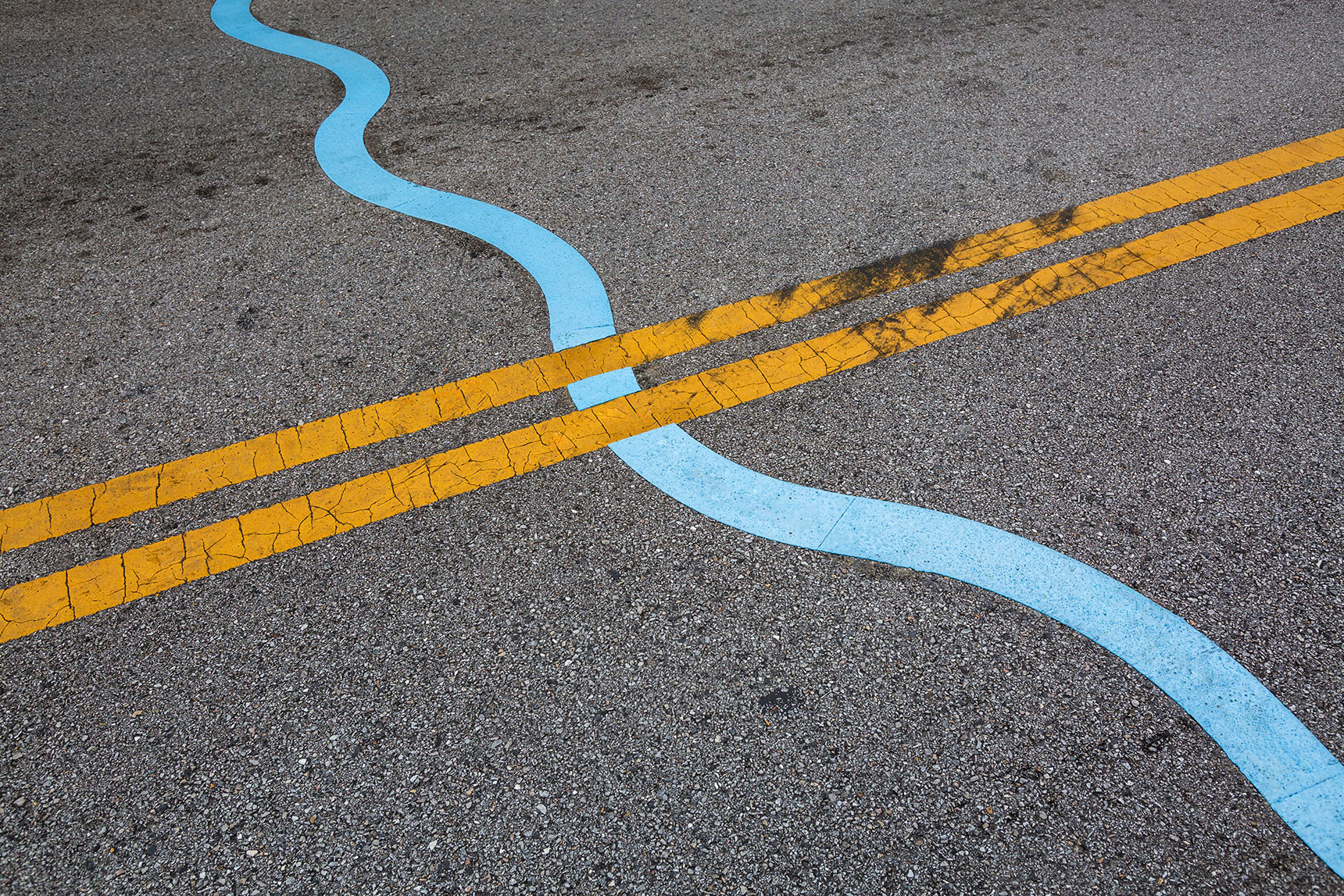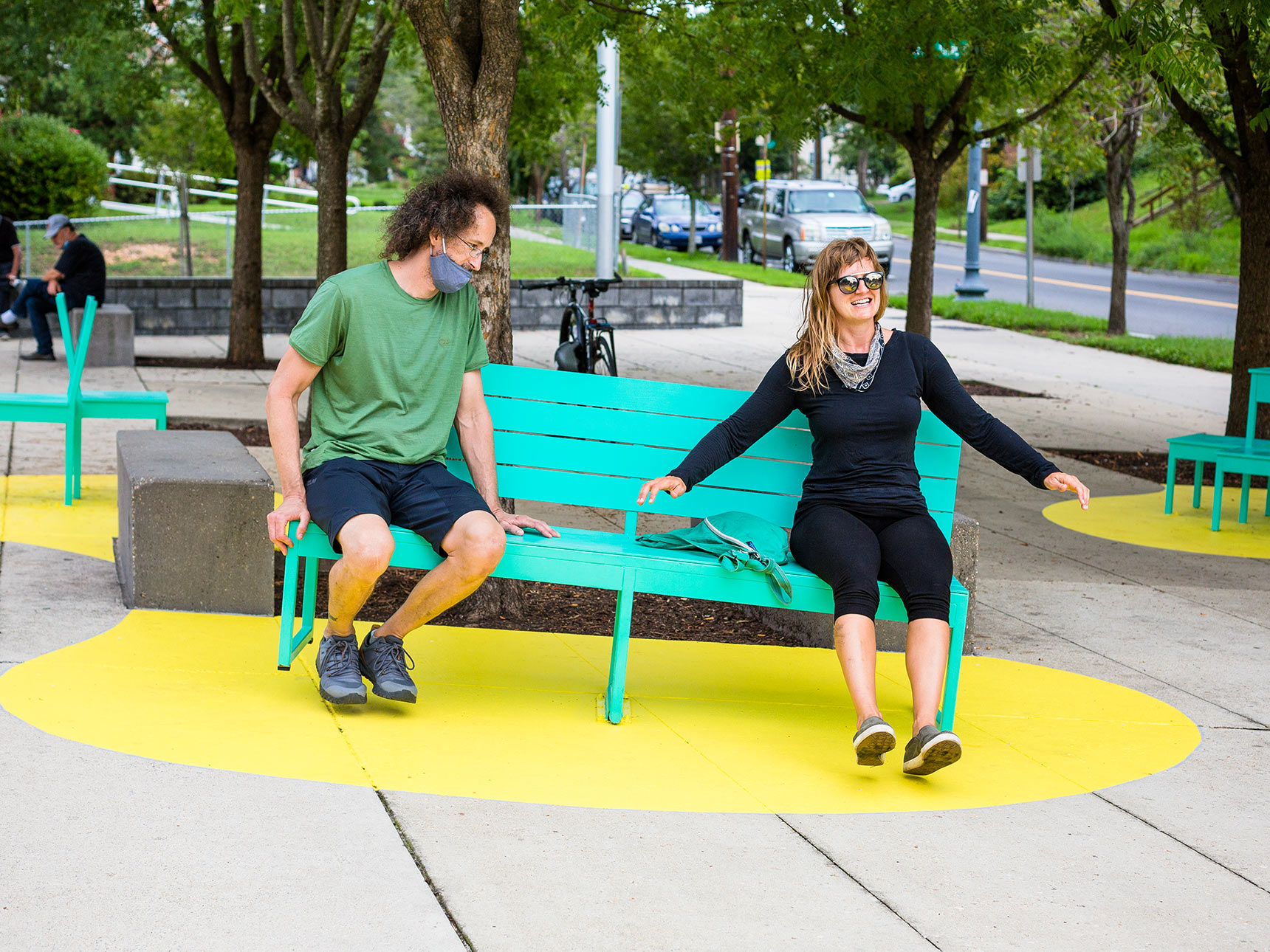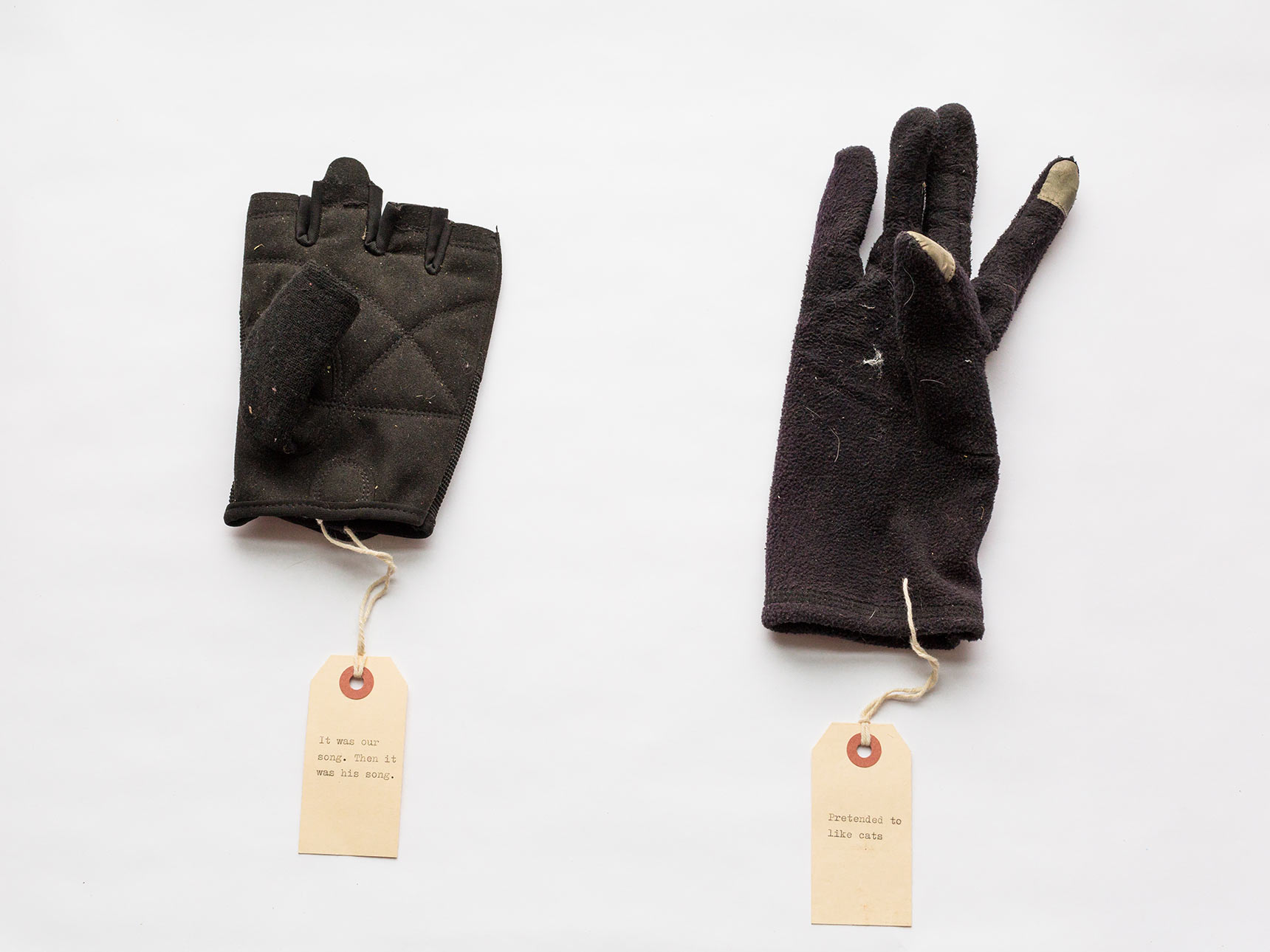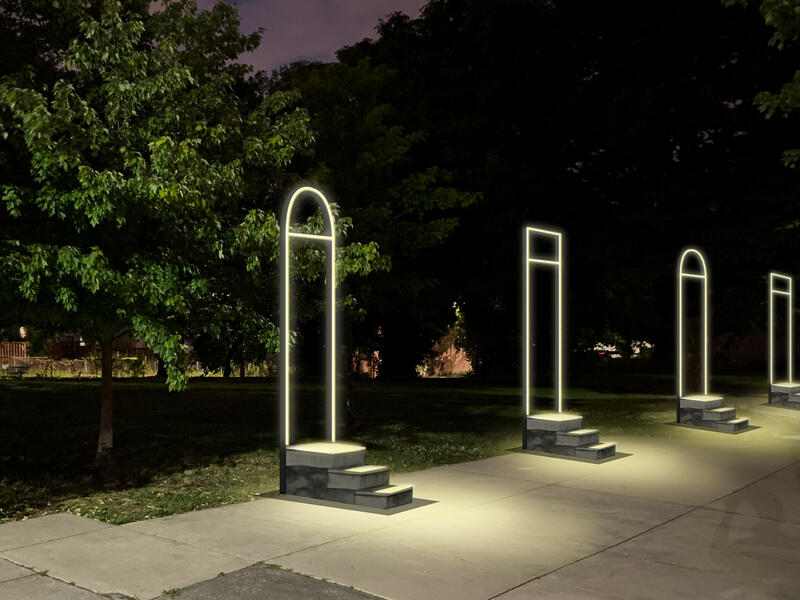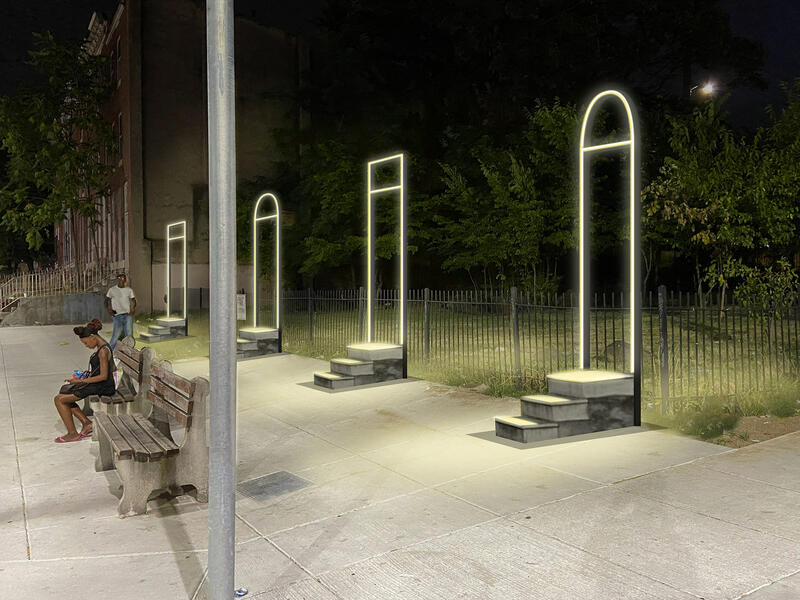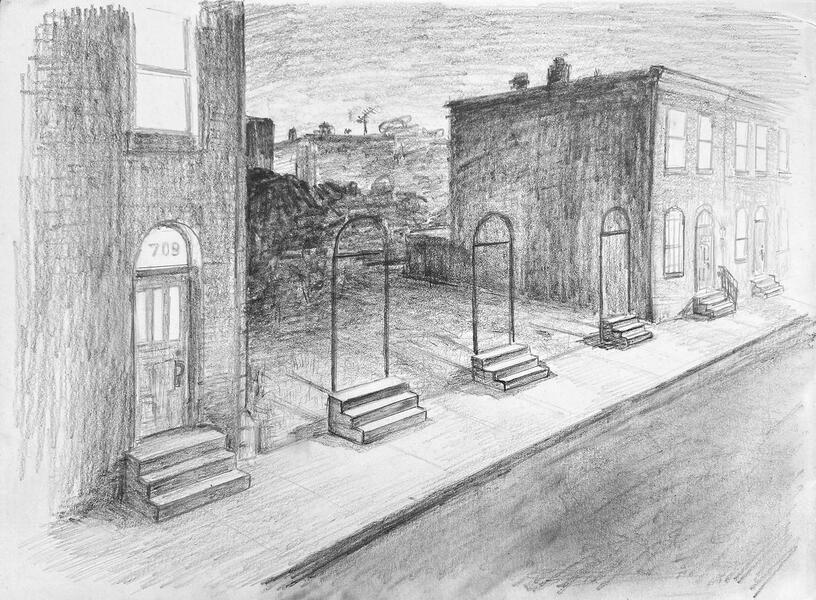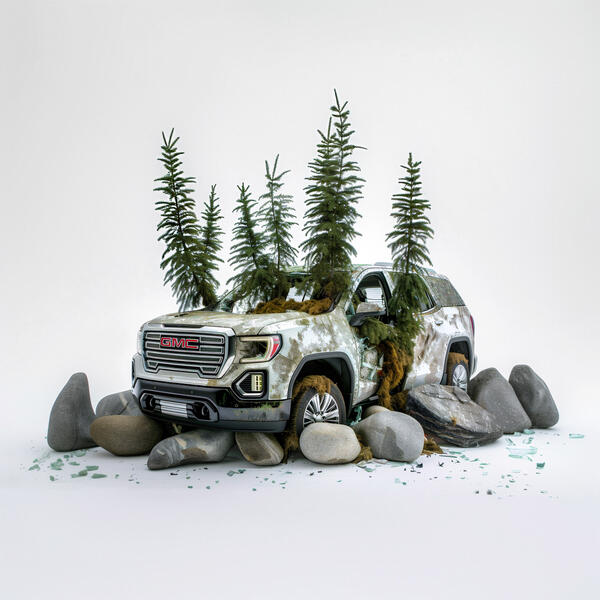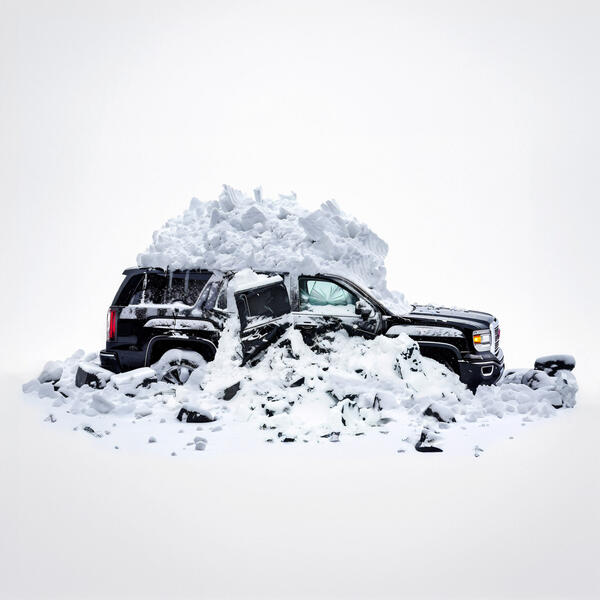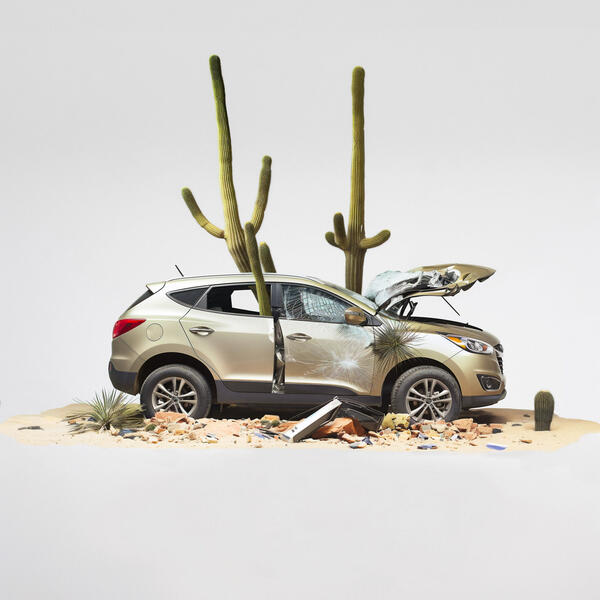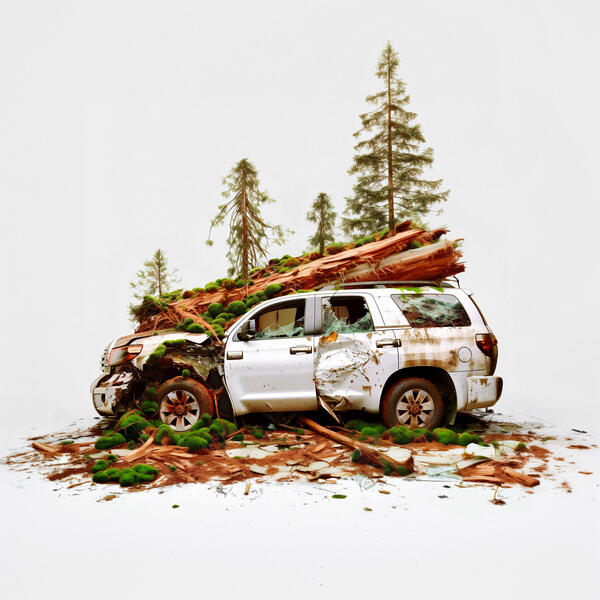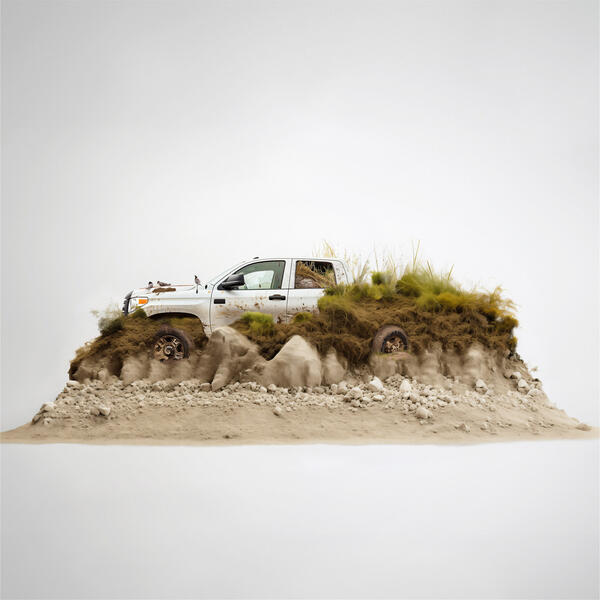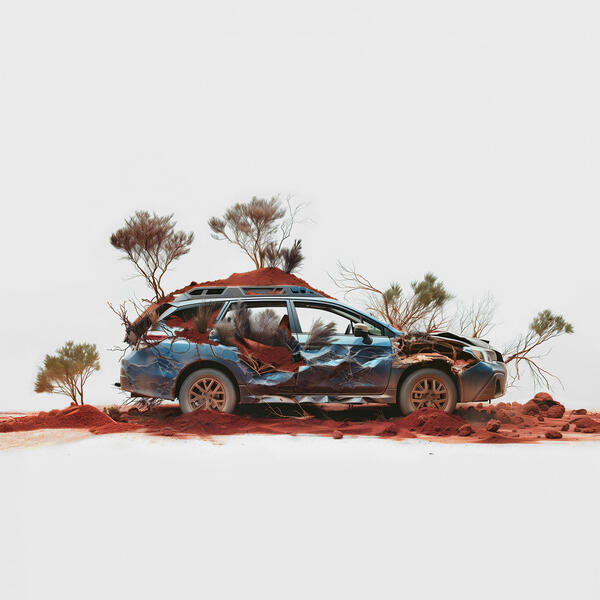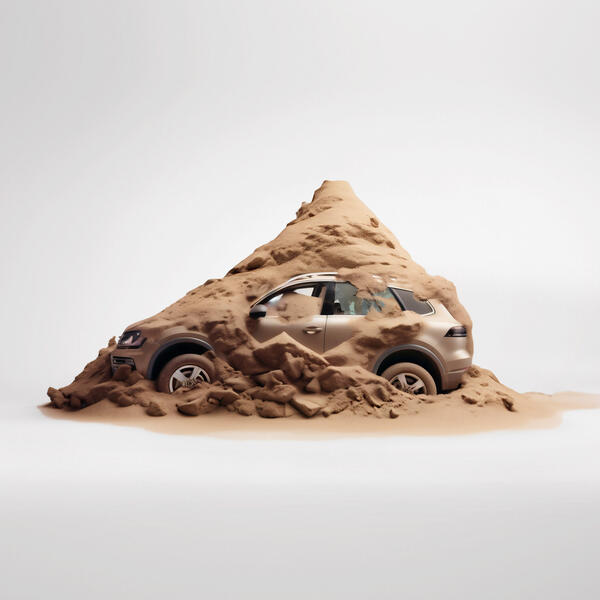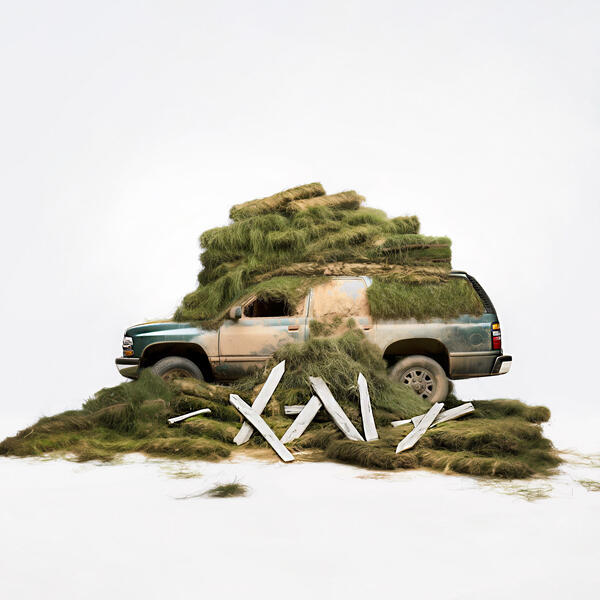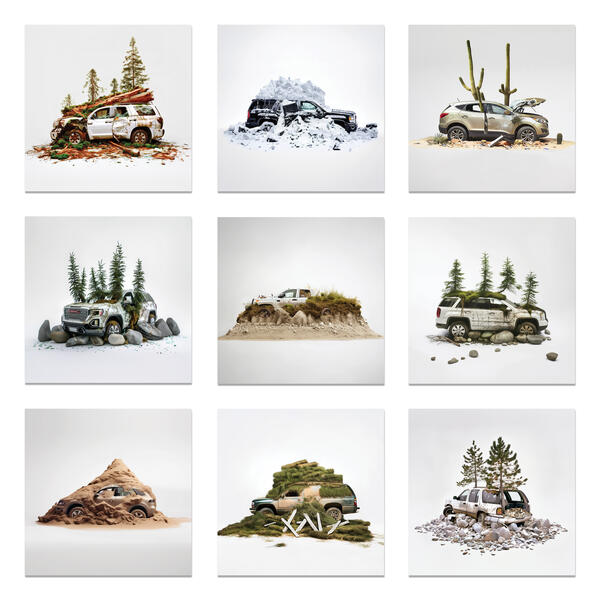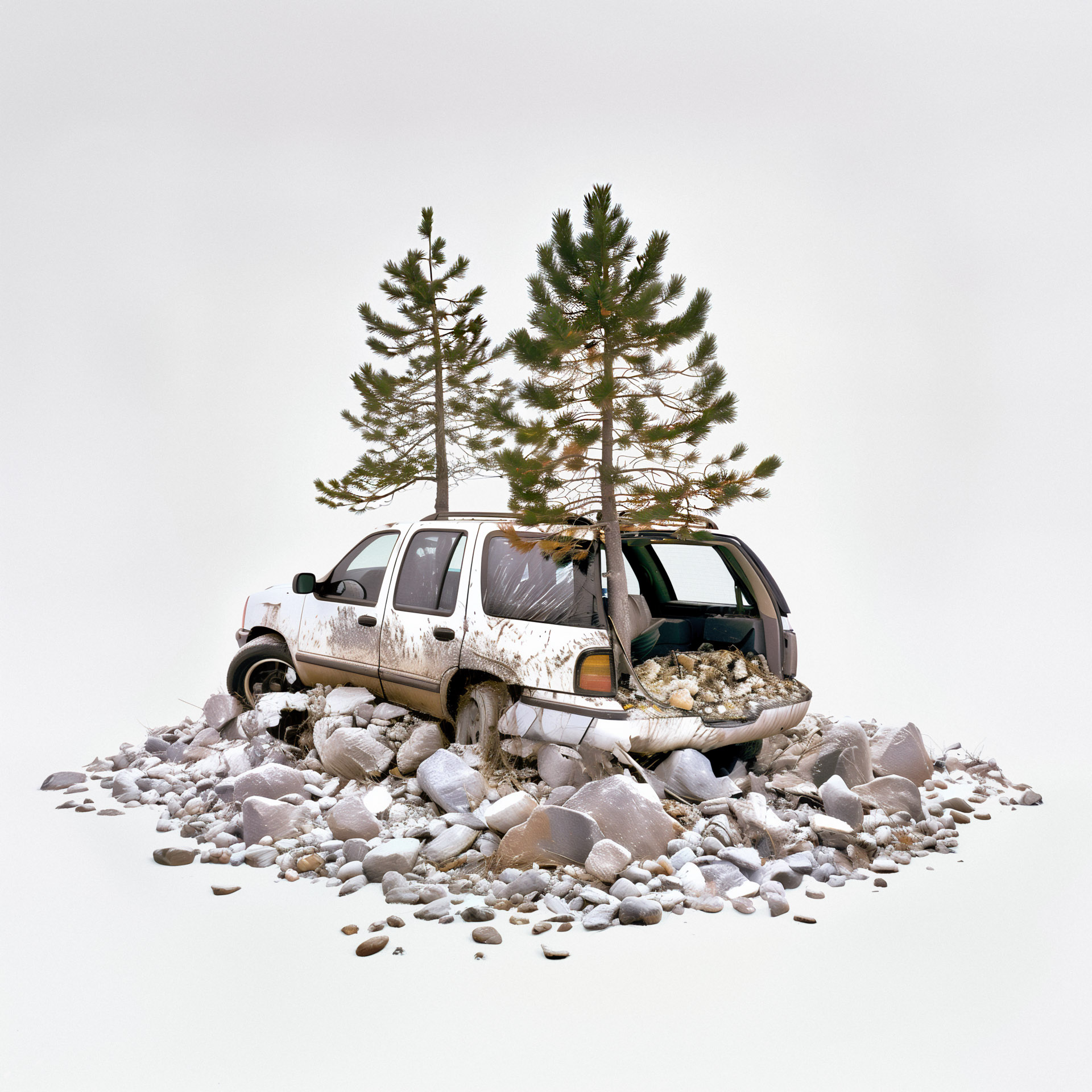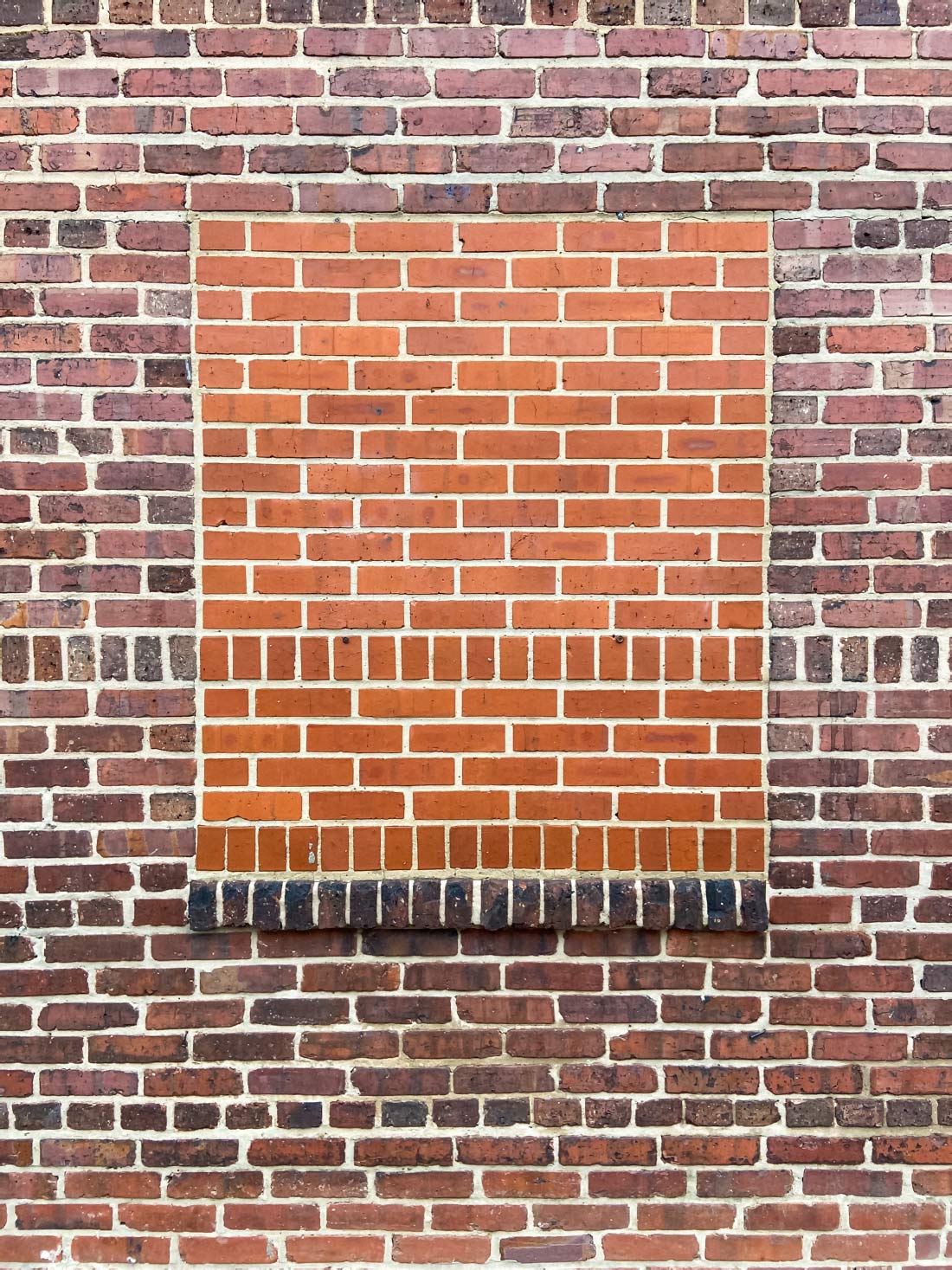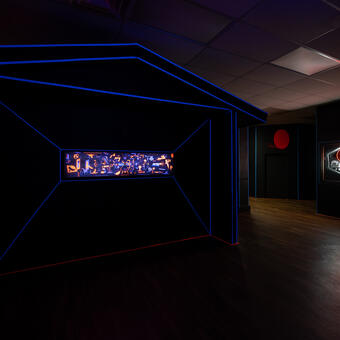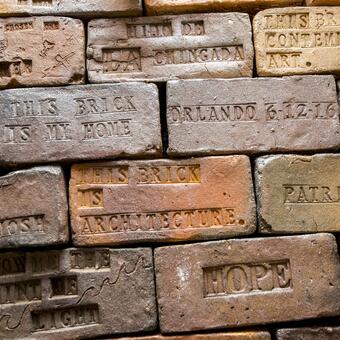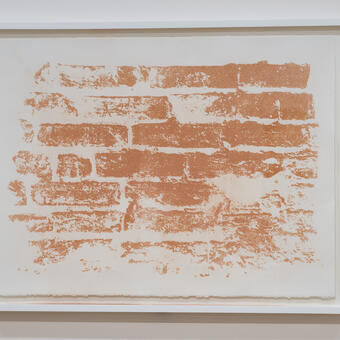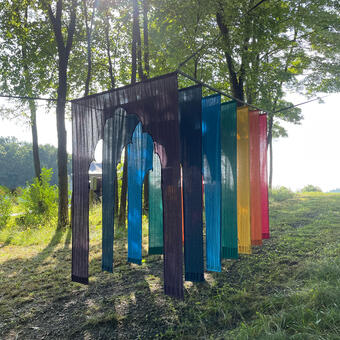Work samples
-
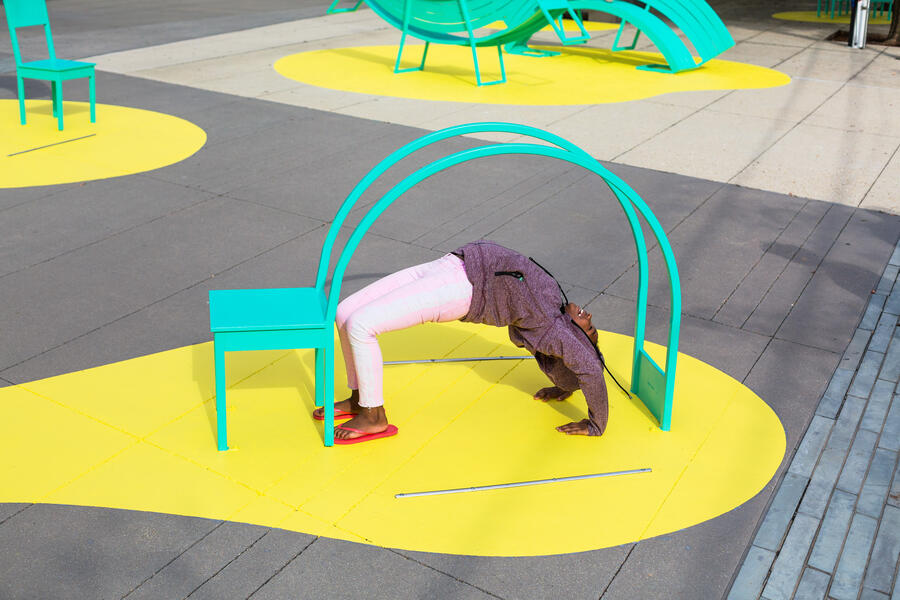 The Chairs
The ChairsThis permanent installation at the Anacostia Public Library plaza reimagines common seating as a form of expression, stretching chairs and benches into surreal and whimsical shapes that activate a sense of play. Each of the eight sculptural seats encourages interaction and offers unique opportunities for play and social engagement.
2020
Painted steel, epoxy pavement coating
Location: Washington, DC (permanent installation) -
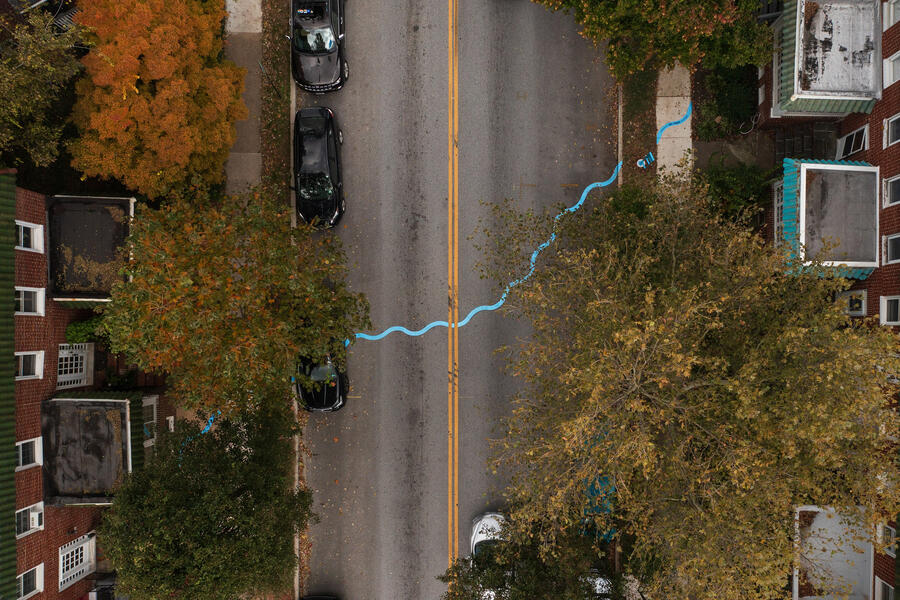 Ghost Rivers
Ghost RiversGhost Rivers is a 1.5-mile-long permanent public art installation and walking tour that reveals the lost path and history of the buried stream Sumwalt Run, which now flows through underground culverts hidden beneath the streets of Baltimore.
2023
Powder-coated steel and aluminum signage, preformed thermoplastic, web publication, research, writings, walking tours, community events
Location: Baltimore, MD
Permanent installation -
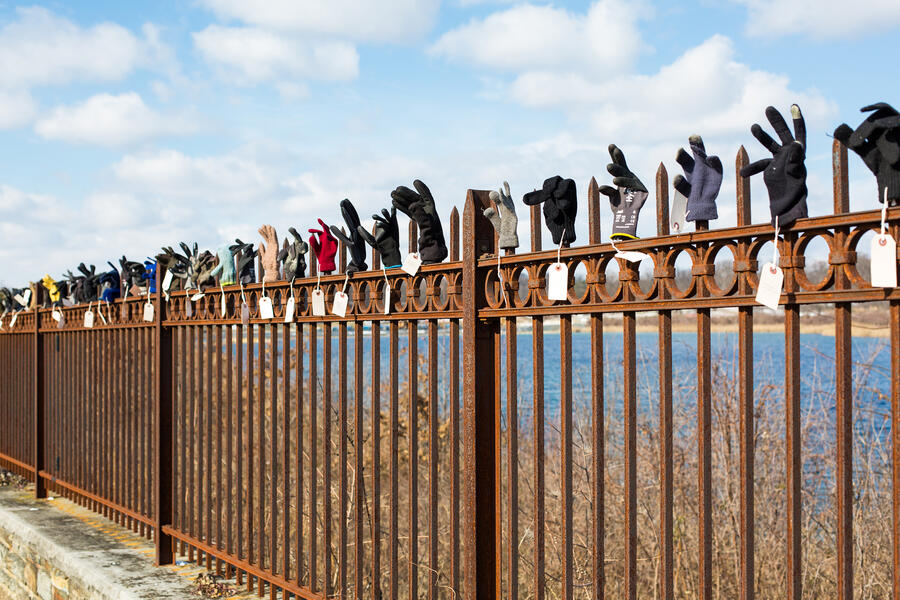 Library of Lost Gloves & Lost Loves
Library of Lost Gloves & Lost LovesThis participatory public art installation at Baltimore’s Druid Hill Park collected orphaned mittens from the gutters and snow banks of nearby neighborhoods, annotated with 1-line love stories/poems. Visitors are invited to “Find a glove, leave a glove. Take a glove, leave a love.”
2022
Found gloves, hang tags, signage
Location: Baltimore, MD -
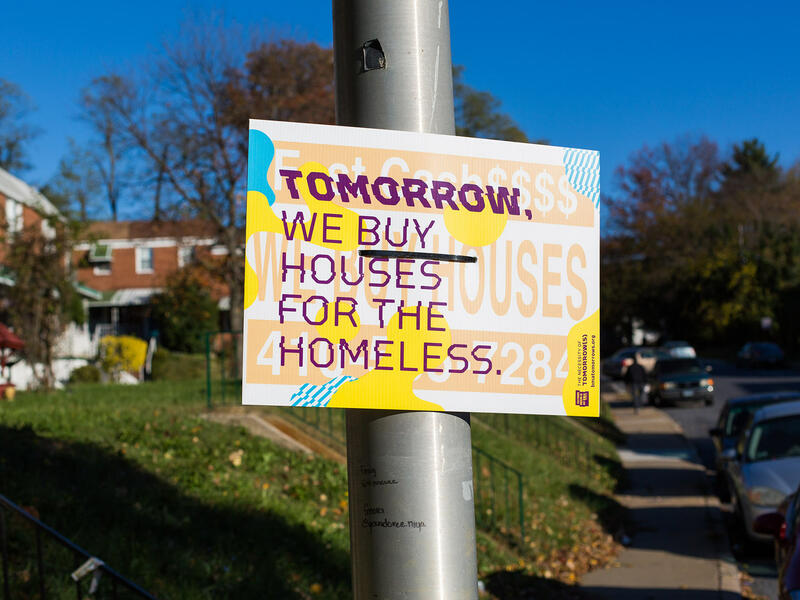 Tomorrow, we buy houses for the homeless.
Tomorrow, we buy houses for the homeless.An interrupted bandit sign from The Necessity of Tomorrow(s) series for the Baltimore Museum of Art. This project included a number of public art interventions and installations in the public realm over the course of three years. By co-opting the forms of vernacular advertising and signage with hopeful expressions, the project aimed to spark discussion on speculative futures at a hyperlocal level.
2018
Screenprinted bandit sign, zip ties
About Bruce
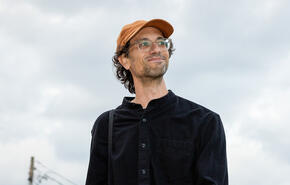
Bruce Willen is a multidisciplinary artist, designer, musician, educator, and the principal of Public Mechanics — a studio focusing on works for public and cultural spaces. Throughout his practice he seeks to bring new perspectives to everyday places, objects, language, and histories. Bruce’s recent work aims to deepen engagement with the landscapes, systems, and symbols around us, fostering moments of discovery and play that open new ways to… more
Ghost Rivers
A multi-site public art installation rediscovering buried streams and lost histories flowing below the streets of Baltimore.
Ghost Rivers is a 1.5-mile-long permanent public art installation and walking tour that reveals the lost path and history of the buried stream Sumwalt Run, which now flows through underground culverts beneath the Remington and Charles Village neighborhoods. Through a series of permanent installations, wayfinding markers, and writings Ghost Rivers brings hidden landscapes and histories to the surface. Along the way the project draws connections between Baltimore’s watershed, its social history, and the evolving relationships between natural and human environments.
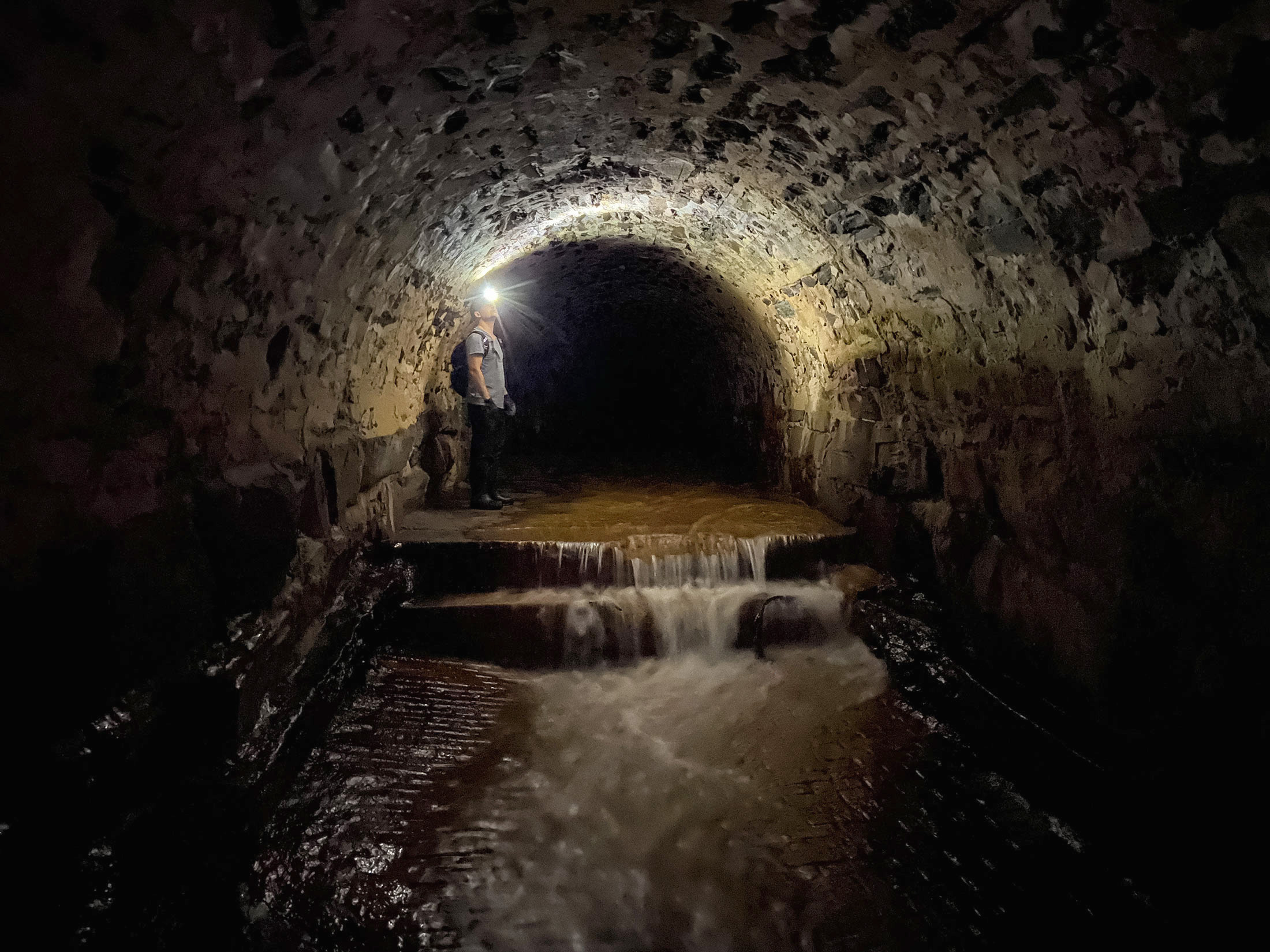
Mapmaking at city-scale
Ghost Rivers installations add a cartographic overlay to the physical environment, a meandering blue line that traces the lost path of Sumwalt Run across city streets and sidewalks. The pale blue color references the hues of waterways found on vintage maps and unites the Ghost Rivers installations across multiple sites. The form and color stands out among other roadway markings and a visually-crowded streetscape to help visitors follow the project through the neighborhood.
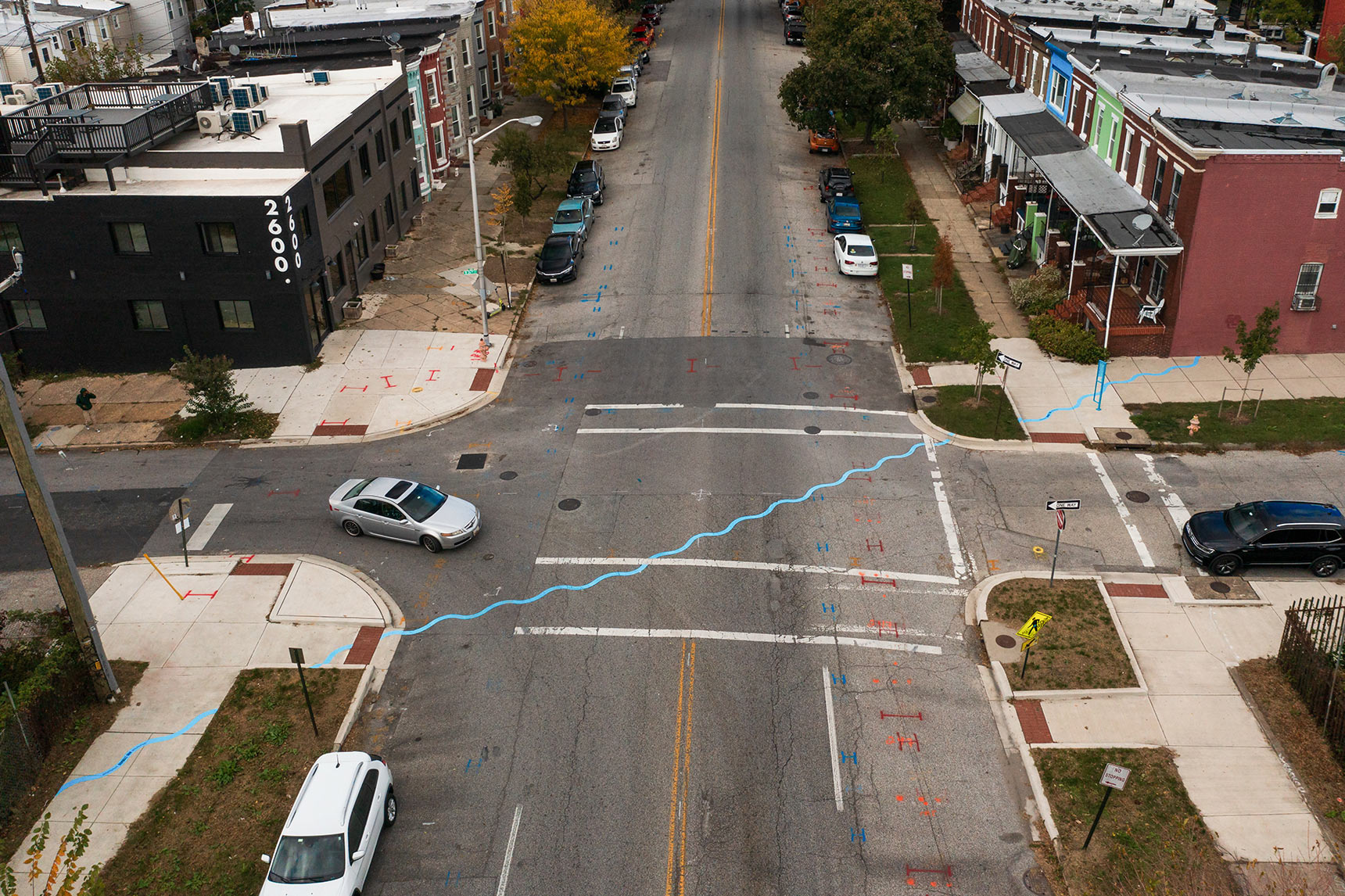
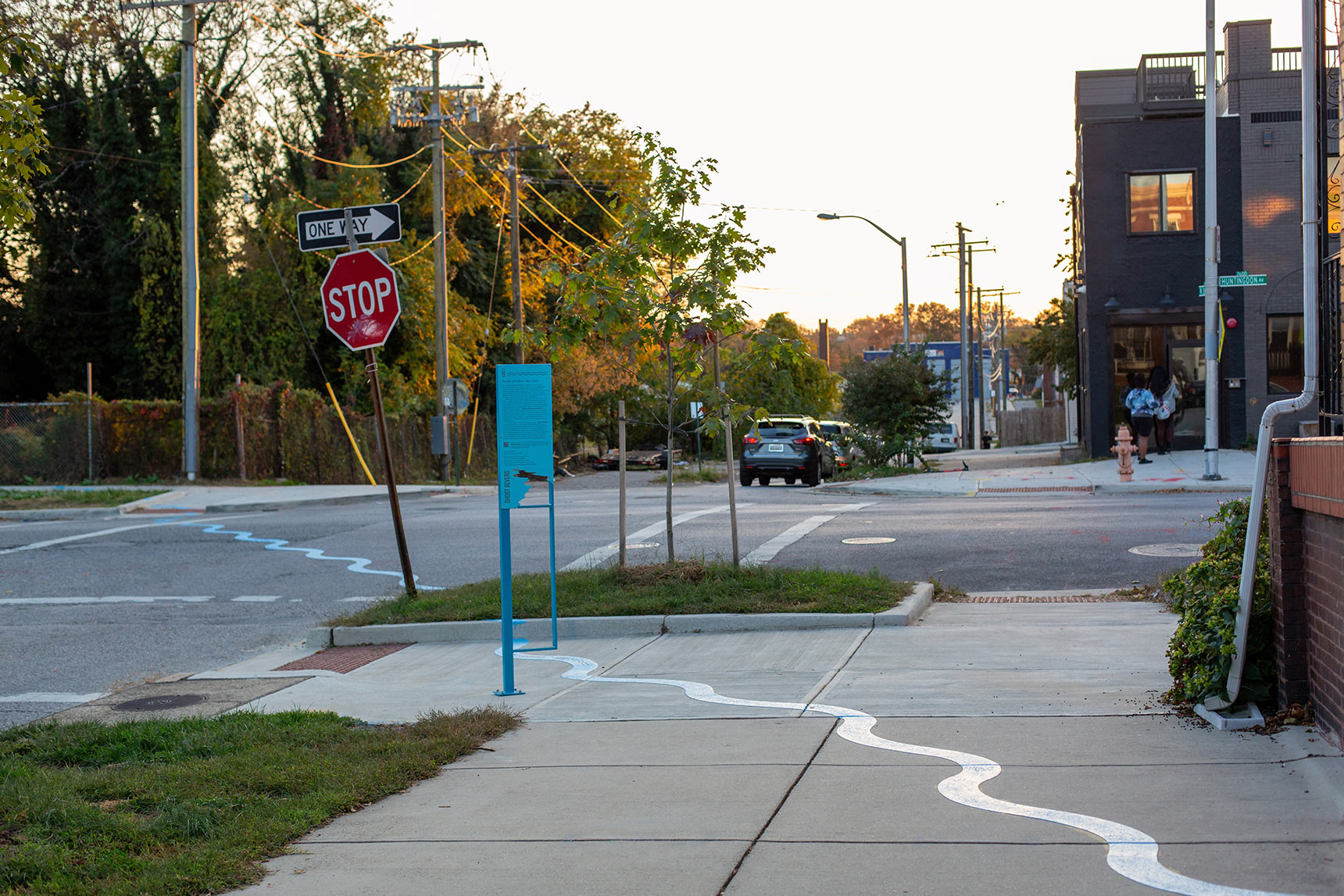
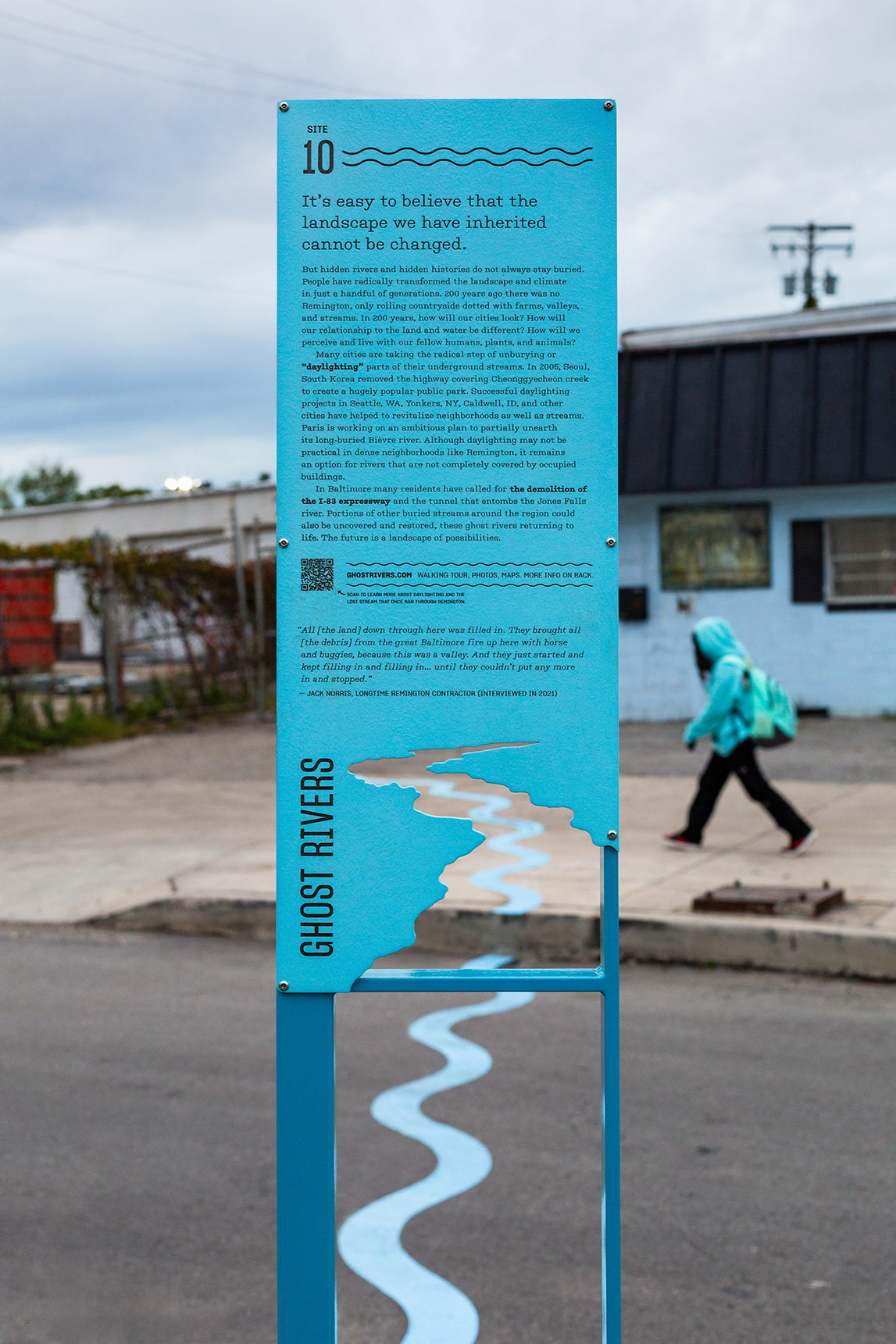
Multiple narrative threads
Visitors may first stumble upon only one or two Ghost Rivers installations, and each site’s accompanying narrative is written as a standalone vignette. As viewers visit multiple sites, these narratives link together to illuminate larger themes within our social and natural landscapes. Sculptural interpretive signs feature cut-out river shapes that help visitors “see” the lost creek and a QR code that links viewers to additional digital content, including photos, historic imagery, and action-oriented resources for each site and topic. A project map on the signage, along with an interactive Google Map, help visitors to navigate a self-guided tour of Ghost Rivers installation sites.
An engaging multimedia website and interactive map serve as digital guides for visitors who wish to tour the sites on their own and for people around the world to experience Ghost Rivers virtually.
An extensive community engagement process
During project development, engagement included community history workshops, public presentations, canvassing, in-person conversations, a collaborative chalk art drawing event, and one-on-one interviews that added voices of longtime neighborhood residents to the project. This broad engagement resulted in strong neighborhood support for Ghost Rivers.
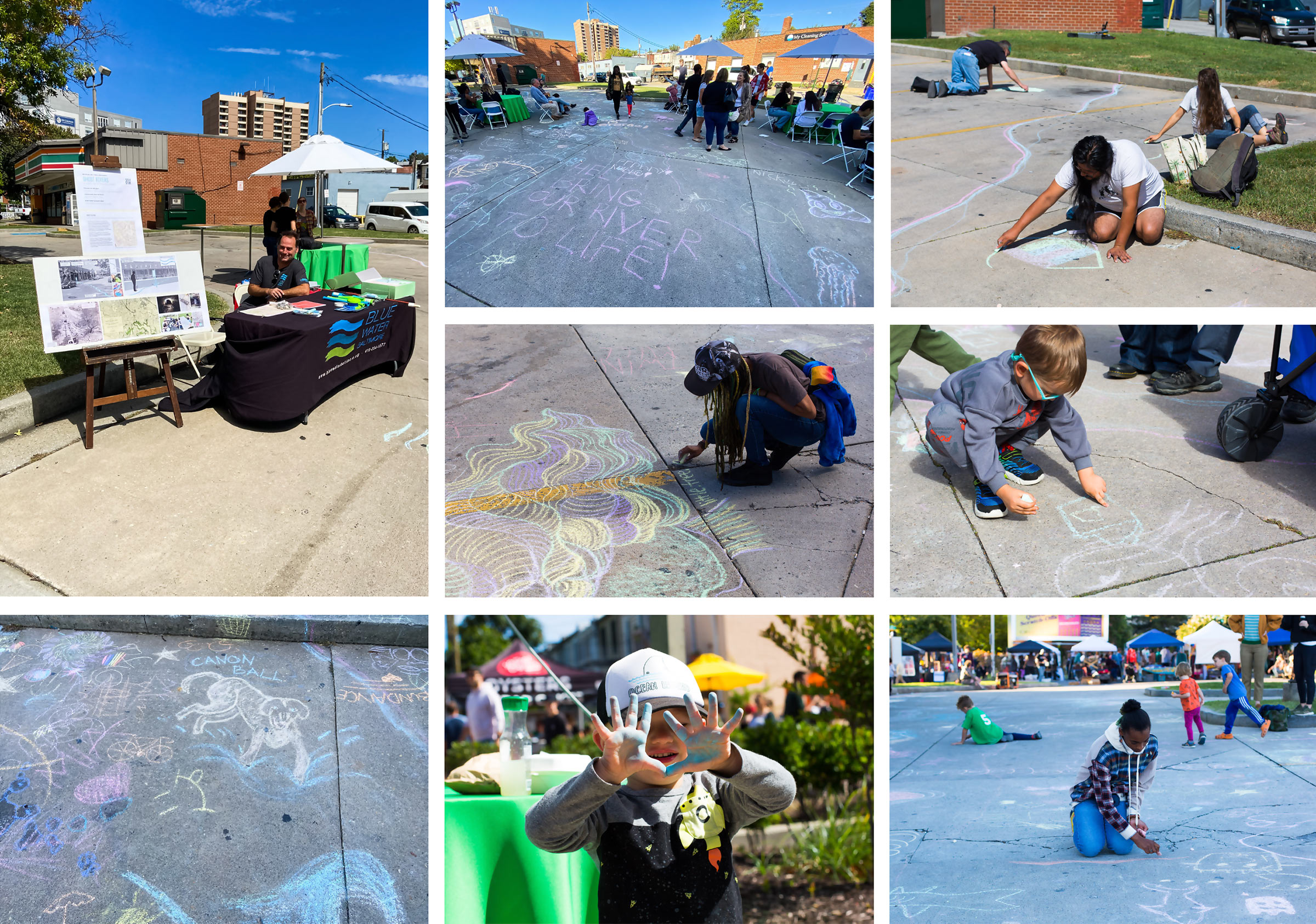
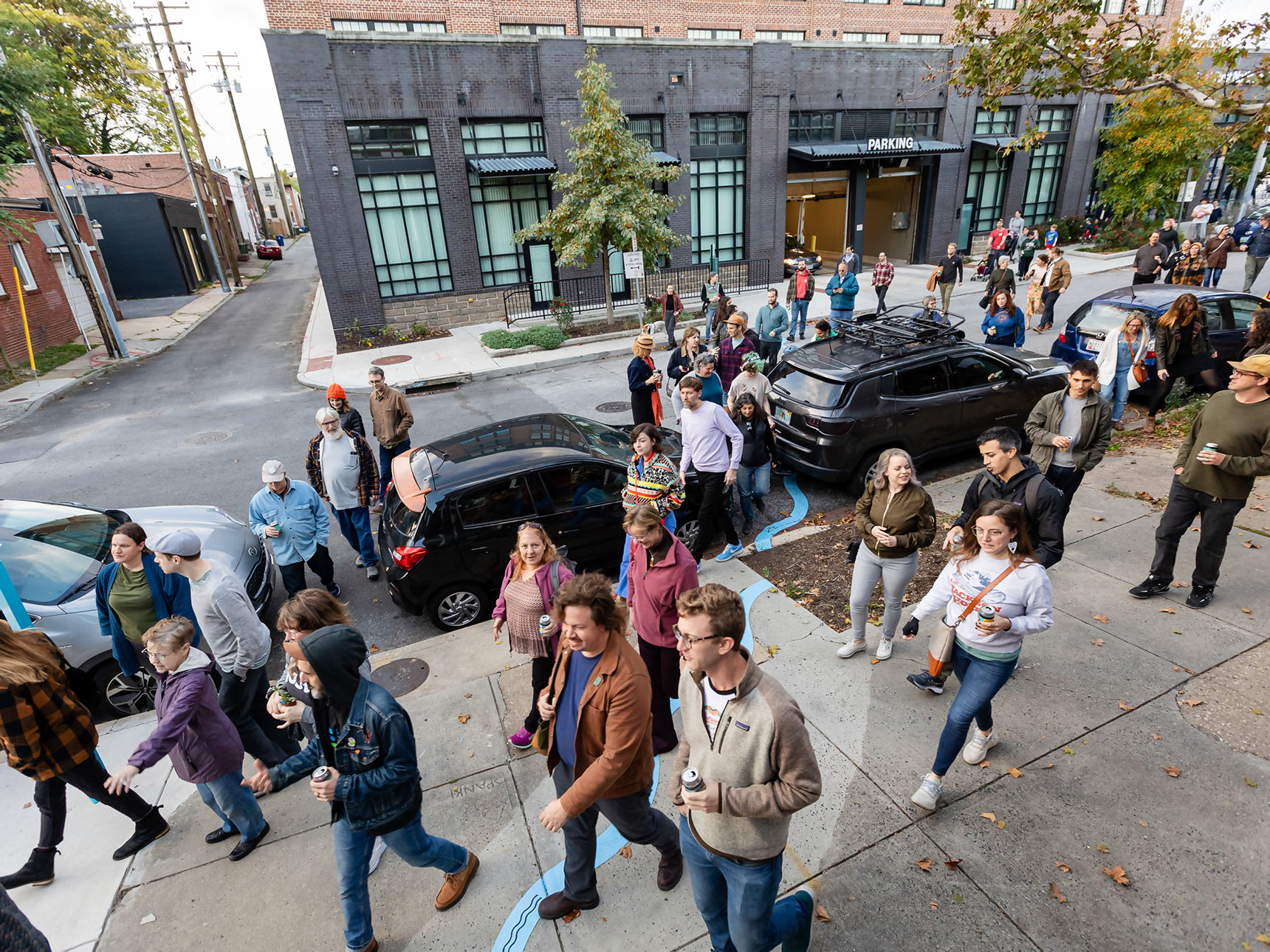

Concept, design, research, writing: Bruce Willen
Fabrication & installation: Elemental Metalworks, Equus Striping, Public Mechanics, Preform, Powder Coat Finishes, Floyd Godsey II
Community & municipal partners: Greater Remington Improvement Association (GRIA), Blue Water Baltimore, Friends of Wyman Park Dell, Baltimore National Heritage Area (BNHA), Baltimore City Department of Transportation, Baltimore City Department of Public Works, Baltimore City Office of Sustainability
Funding & in-kind support: Maryland State Arts Council, Gutierrez Memorial Fund, Maryland Heritage Areas Authority, Chesapeake Bay Trust, Baltimore City Department of Public Works, Spiniello (in-kind)
Website development: Public Mechanics & Oleksandr Khudonohov
Additional research assistance: Micah Connor, Kathleen C. Ambrose, Ronald Parks
-
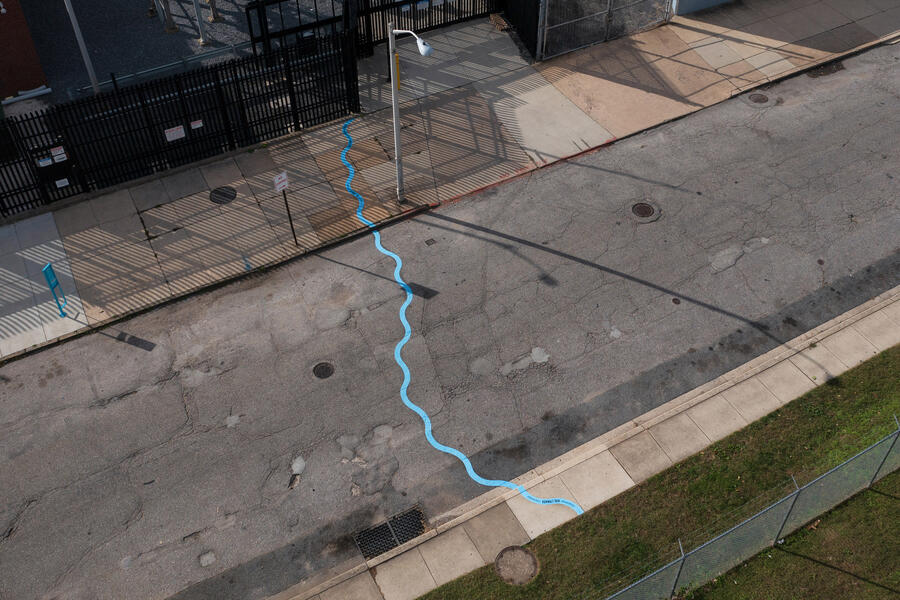 Ghost Rivers site 11 (aerial view)
Ghost Rivers site 11 (aerial view)2023
Powder-coated steel and aluminum signage, preformed thermoplastic, web publication, research, writings, walking tours, community events
Location: Baltimore, MD
Permanent installation(Photo by Frank Hamilton)
-
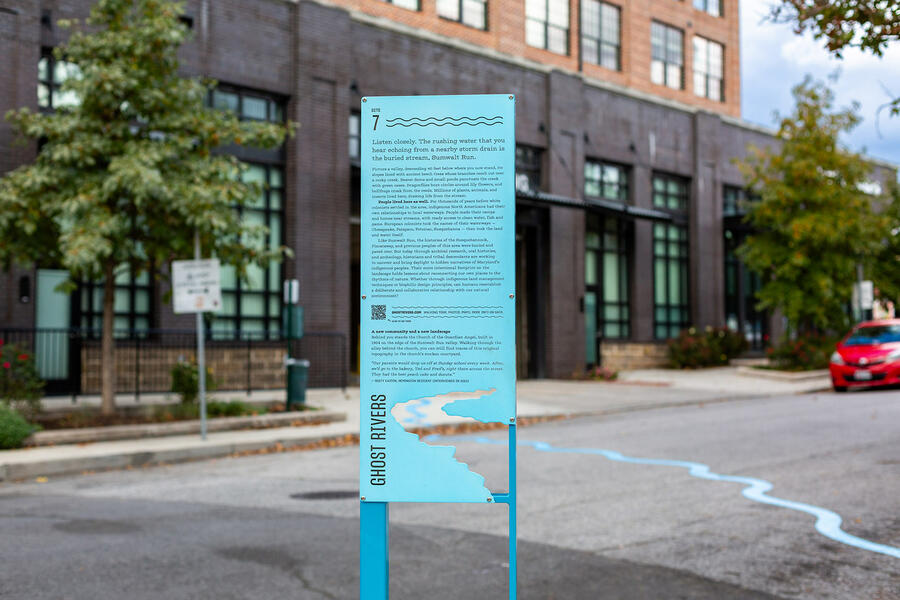 Ghost Rivers site 7 (detail of sculptural signage)
Ghost Rivers site 7 (detail of sculptural signage)2023
Powder-coated steel and aluminum signage, preformed thermoplastic, web publication, research, writings, walking tours, community events
Location: Baltimore, MD
Permanent installation -
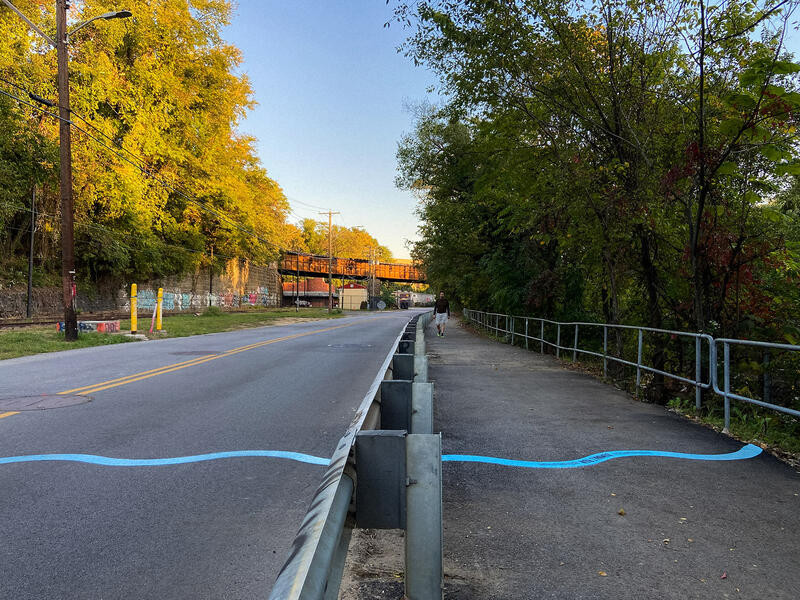 Ghost Rivers site 12
Ghost Rivers site 122023
Powder-coated steel and aluminum signage, preformed thermoplastic, web publication, research, writings, walking tours, community events
Location: Baltimore, MD
Permanent installation -
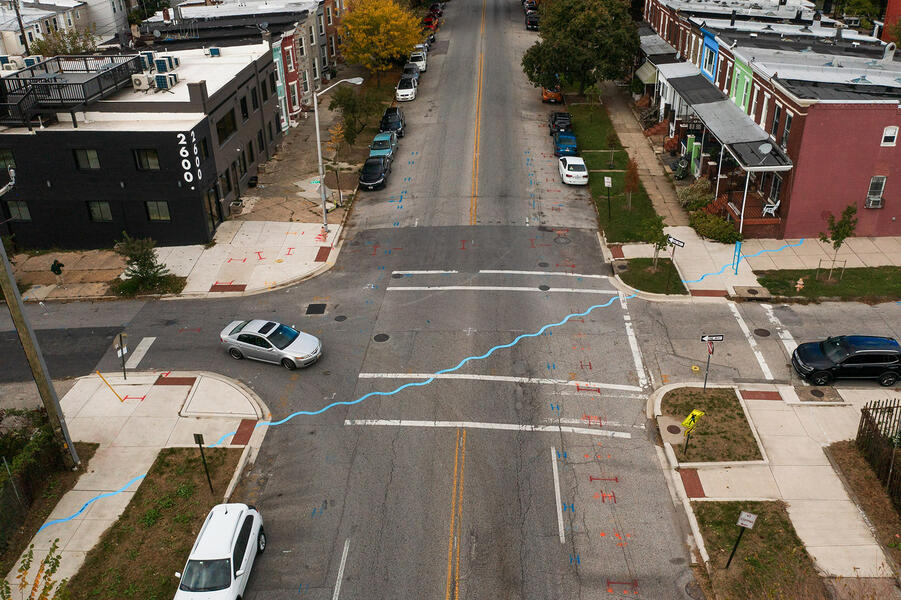 Ghost Rivers site 9 (aerial view)
Ghost Rivers site 9 (aerial view)2023
Powder-coated steel and aluminum signage, preformed thermoplastic, web publication, research, writings, walking tours, community events
Location: Baltimore, MD
Permanent installation(Photo by Frank Hamilton)
-
 Ghost Rivers site 3 (detail)
Ghost Rivers site 3 (detail)2023
Powder-coated steel and aluminum signage, preformed thermoplastic, web publication, research, walking tours, community events
Location: Baltimore, MD
Permanent installation -
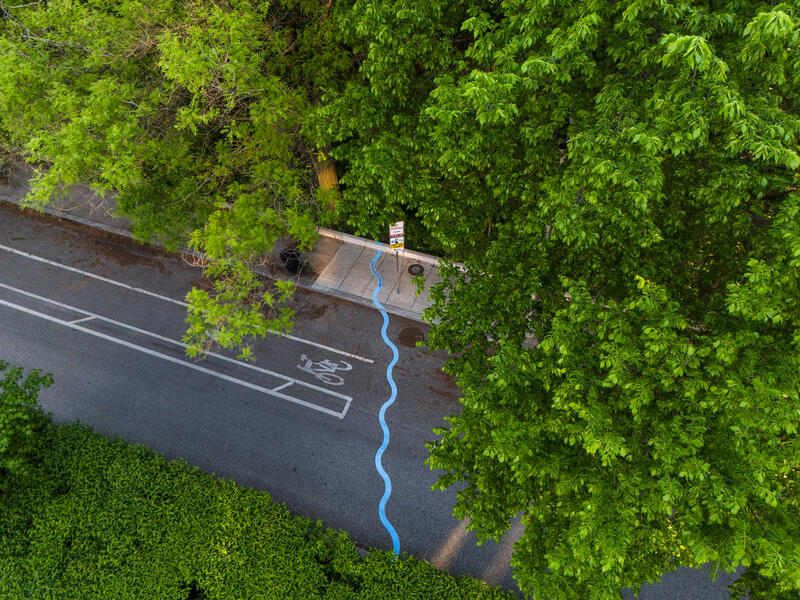 Ghost Rivers site 1 (aerial view)
Ghost Rivers site 1 (aerial view)2024
Powder-coated steel and aluminum signage, preformed thermoplastic, web publication, research, writings, walking tours, community events
Location: Baltimore, MD
Permanent installation(photo by Dave Cooper)
-
 Ghost Rivers site 10 (detail of sculptural signage)
Ghost Rivers site 10 (detail of sculptural signage)2023
Powder-coated steel and aluminum signage, preformed thermoplastic, web publication, research, writings, walking tours, community events
Location: Baltimore, MD
Permanent installation -
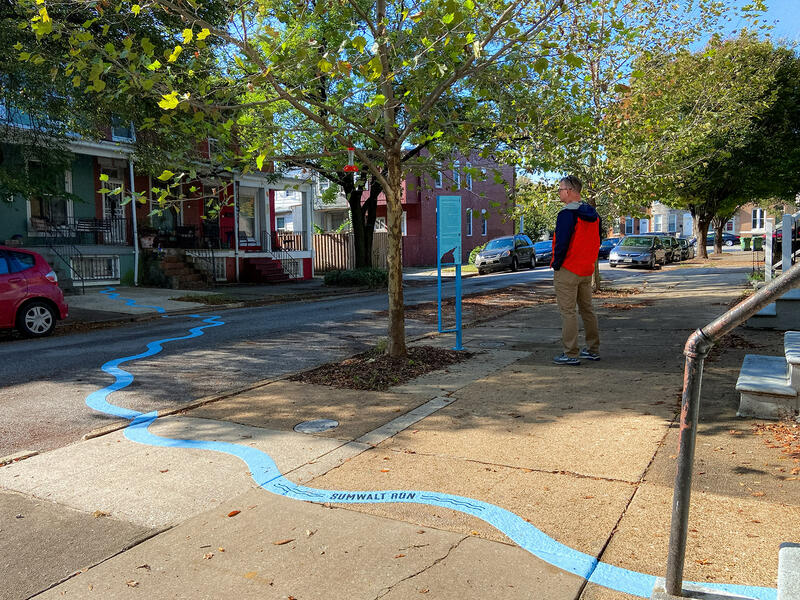 Ghost Rivers site 8
Ghost Rivers site 82023
Powder-coated steel and aluminum signage, preformed thermoplastic, web publication, research, writings, walking tours, community events
Location: Baltimore, MD
Permanent installation -
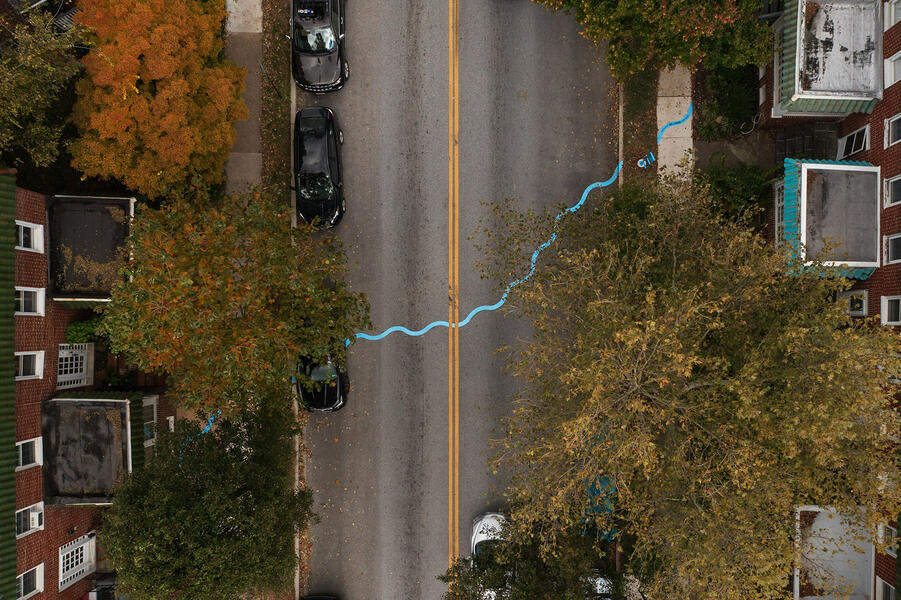 Ghost Rivers site 3 (aerial view)
Ghost Rivers site 3 (aerial view)2023
Powder-coated steel and aluminum signage, preformed thermoplastic, web publication, research, writings, walking tours, community events
Location: Baltimore, MD
Permanent installation(photo by Frank Hamilton)
-
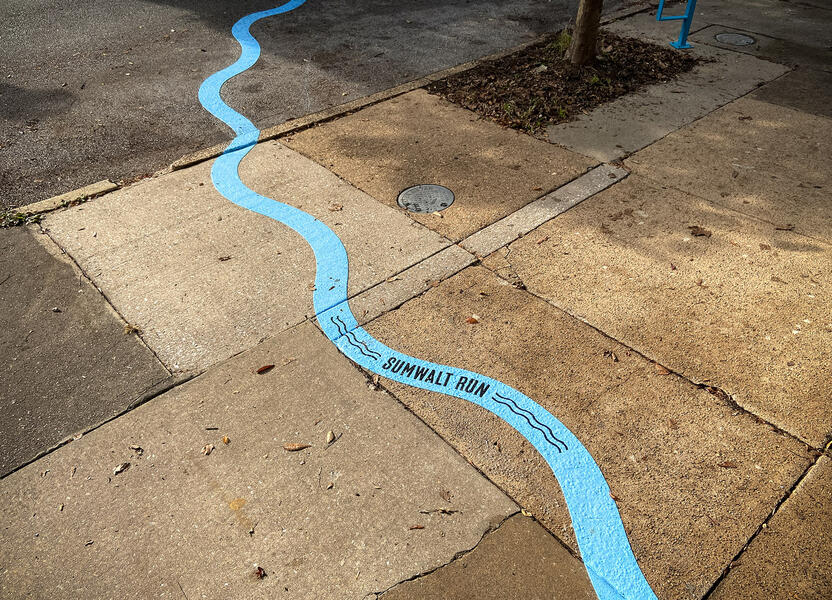 Ghost Rivers site 8 (detail)
Ghost Rivers site 8 (detail)2023
Powder-coated steel and aluminum signage, preformed thermoplastic, web publication, research, writings, walking tours, community events
Location: Baltimore, MD
Permanent installation
The Chairs
Playable art
This permanent installation at the Anacostia Public Library plaza reimagines common seating as a form of expression, stretching chairs and benches into surreal and whimsical shapes that activate a sense of play. Each of the eight sculptural seats encourages interaction and offers unique opportunities for play and social engagement.
2020
Painted steel, epoxy pavement coating
Location: Washington, DC (permanent installation)
Lead artist: Bruce Willen
Additional project team: Sarah Templin, Katryna Carter, Briony Hynson, Tim Scofield
Collaborators: the Neighborhood Design Center, Tim Scofield Studio, Graham Projects
Commissioning Agencies: D.C. Commission on the Arts & Humanities, D.C. Office of Planning
-
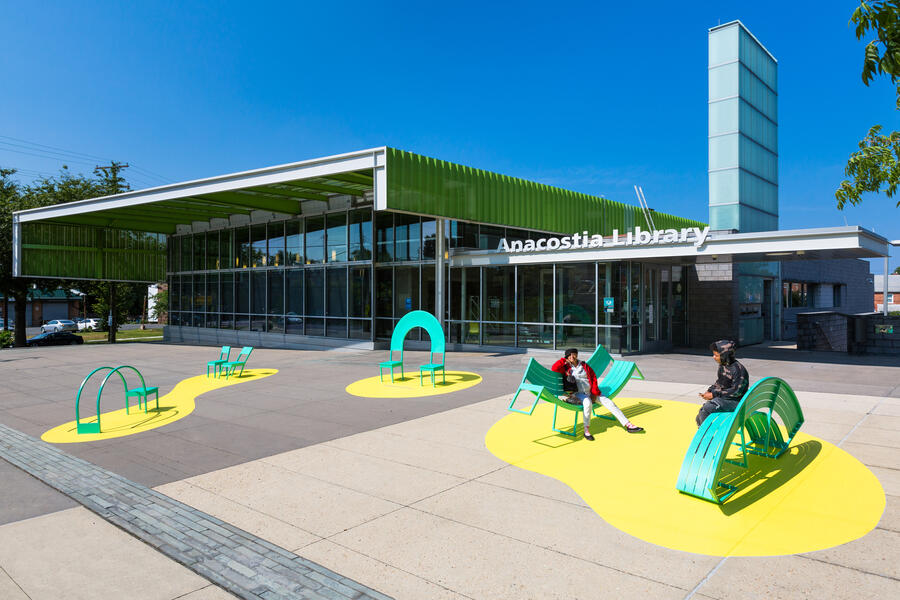 The Chairs
The ChairsThe Chairs
2020
Painted steel, epoxy pavement coating
Location: Washington, DC -
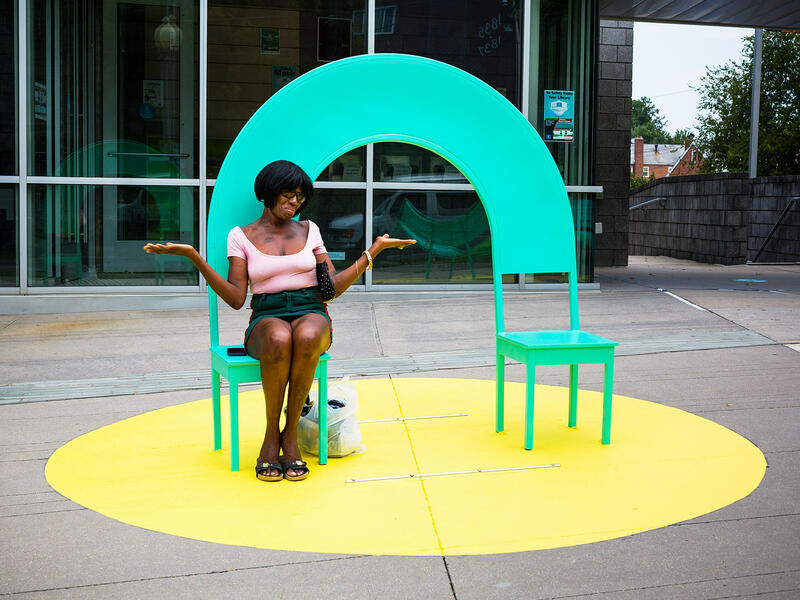 Rainbow Chair
Rainbow ChairThe Chairs
2020
Painted steel, epoxy pavement coating
Location: Washington, DC -
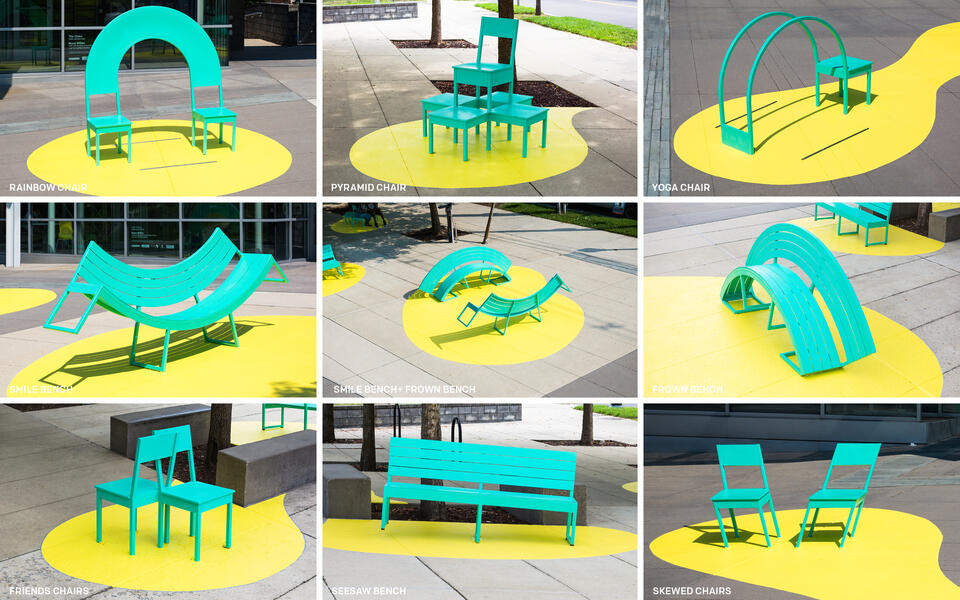 The installation comprises eight sculptural chairs and benches
The installation comprises eight sculptural chairs and benchesEach seat creates unique opportunities for interaction and play.
The Chairs
2020
Painted steel, epoxy pavement coating
Location: Washington, DC -
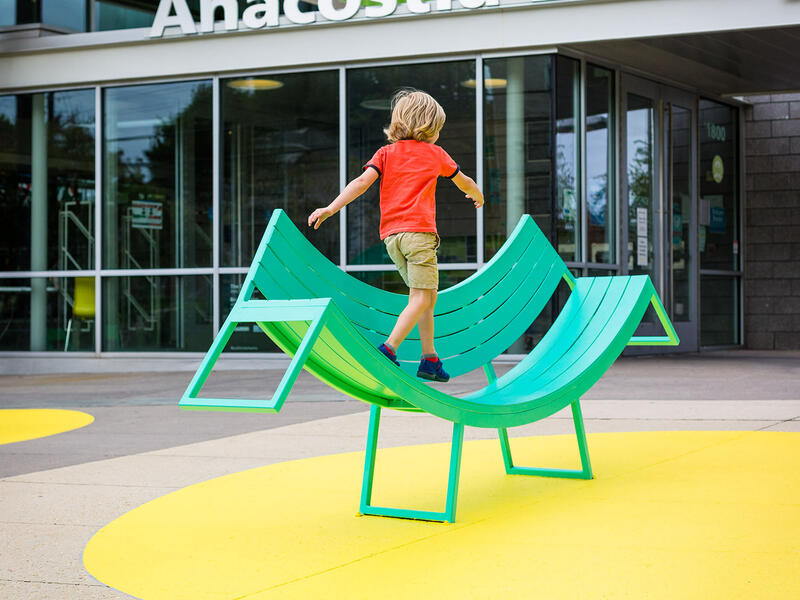 Smile Bench
Smile BenchThe Chairs
2020
Painted steel, epoxy pavement coating
Location: Washington, DC -
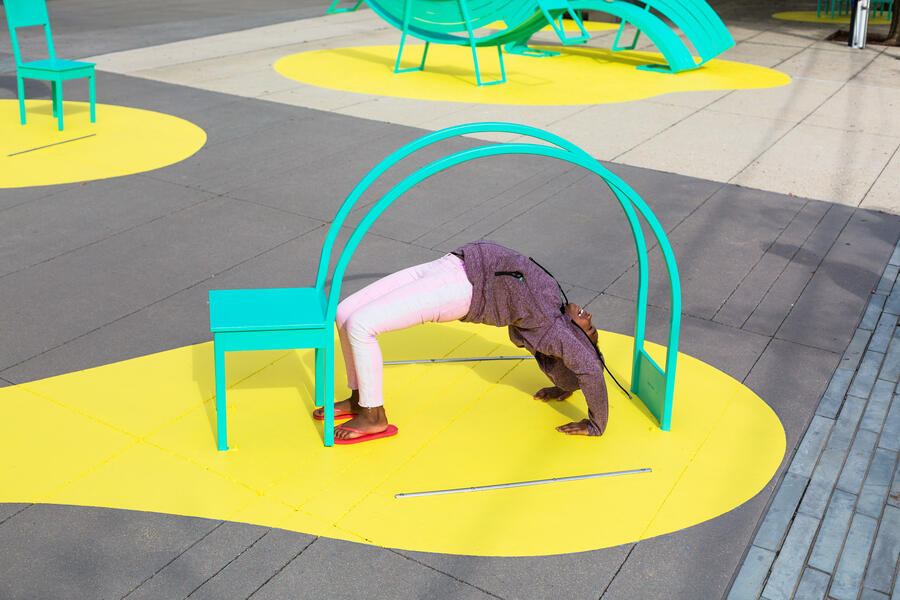 Yoga Chair
Yoga Chair2020
Painted steel, epoxy pavement coating
Location: Washington, DC -
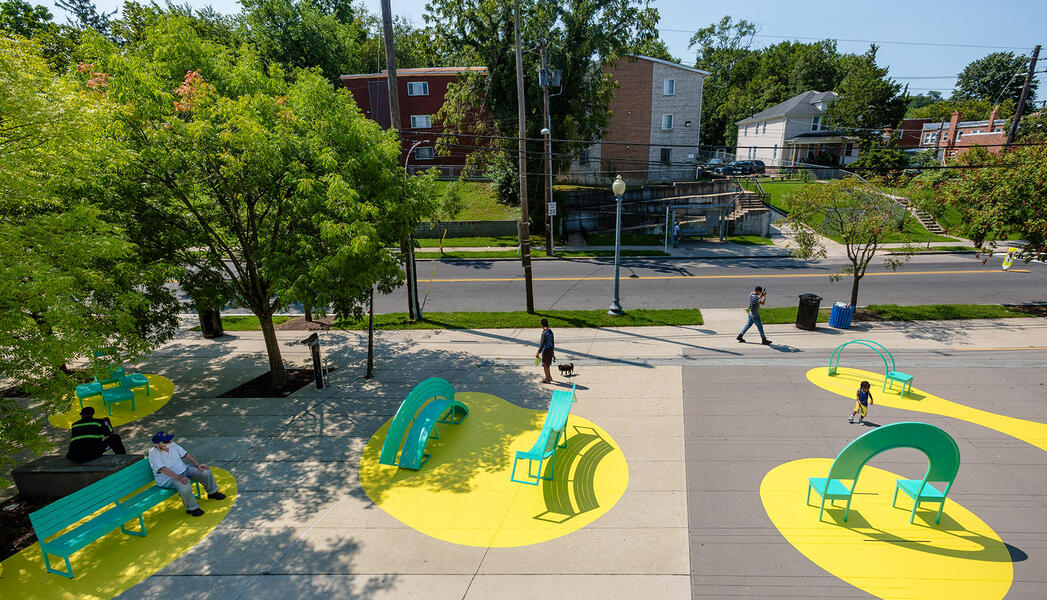 The Chairs
The ChairsThe Chairs
2020
Painted steel, epoxy pavement coating
Location: Washington, DC -
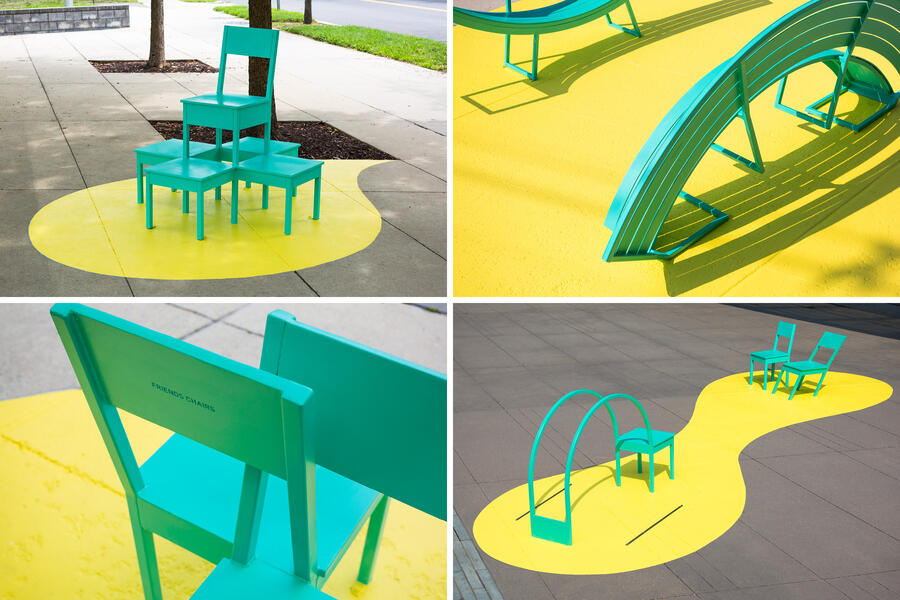 The Chairs
The ChairsThe Chairs
2020
Painted steel, epoxy pavement coating
Location: Washington, DC -
 Seesaw Bench
Seesaw BenchThe Chairs
2020
Painted steel, epoxy pavement coating
Location: Washington, DC -
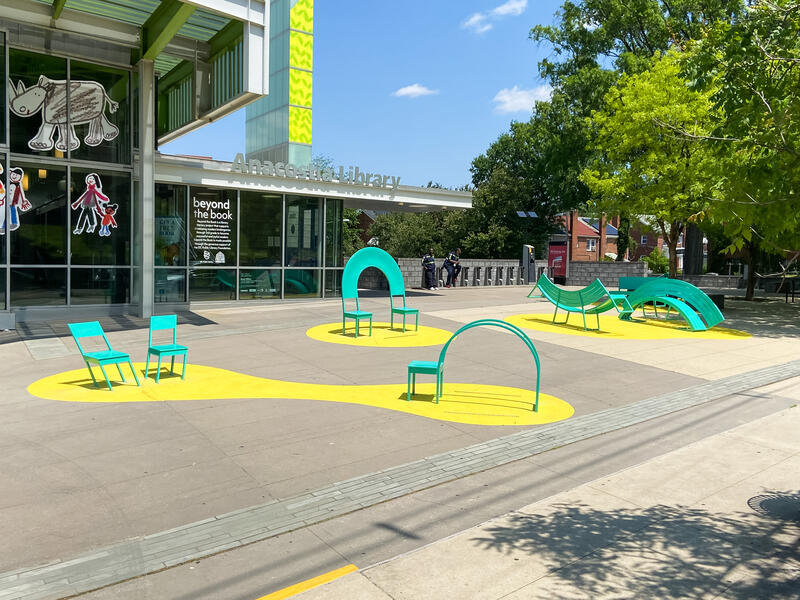 The Chairs
The Chairs2020
Painted steel, epoxy pavement coating
Location: Washington, DC -
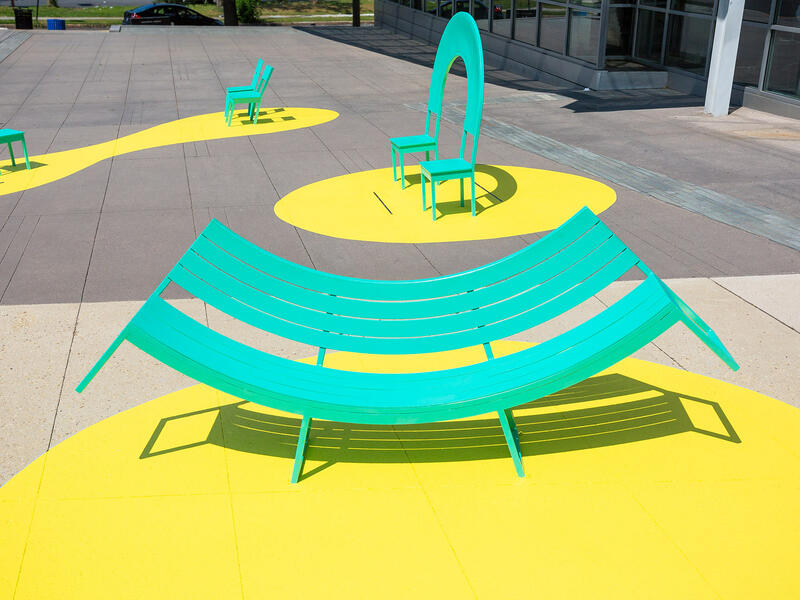 Smile Bench, Rainbow Chair, Skewed Chairs
Smile Bench, Rainbow Chair, Skewed ChairsThe Chairs
2020
Painted steel, epoxy pavement coating
Location: Washington, DC
Library of Lost Gloves & Lost Loves
Find a glove, leave a glove. Take a glove, leave a love.
This participatory public art installation at Baltimore’s Druid Hill Park collected orphaned mittens from the gutters and snow banks of nearby neighborhoods, annotated with 1-line love stories/poems. People are invited to “Find a glove, leave a glove. Take a glove, leave a love.”
2022
Found gloves, hang tags, signage
Location: Baltimore, MD
Collaborators: Sarah Templin, the people of Baltimore
-
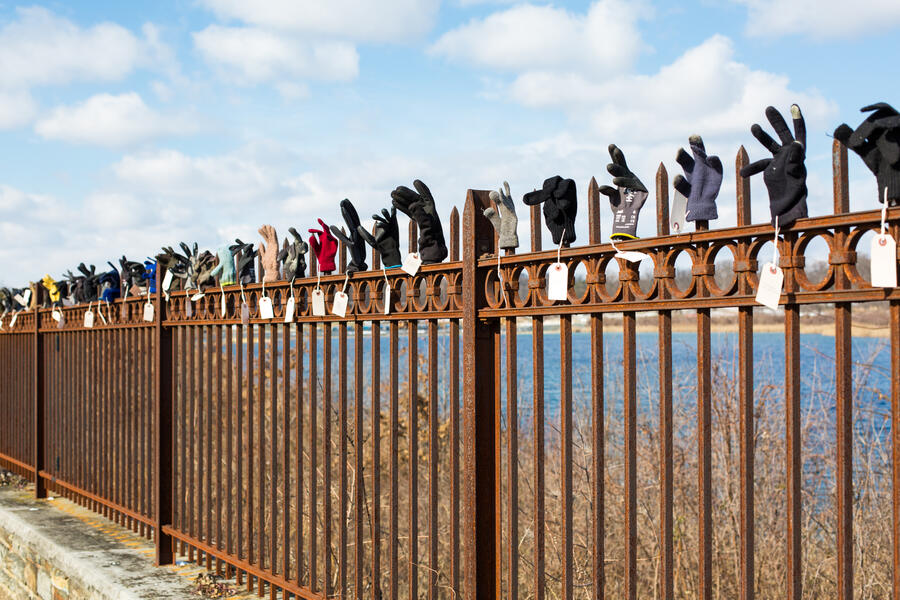 Library of Lost Gloves & Lost Loves
Library of Lost Gloves & Lost Loves2022
Found gloves, hang tags, signage
Location: Baltimore, MD -
Library of Lost Gloves & Lost Loves
Video documentation of the installation at Druid Hill Park.
2022
Found gloves, hang tags, signage
Location: Baltimore, MD -
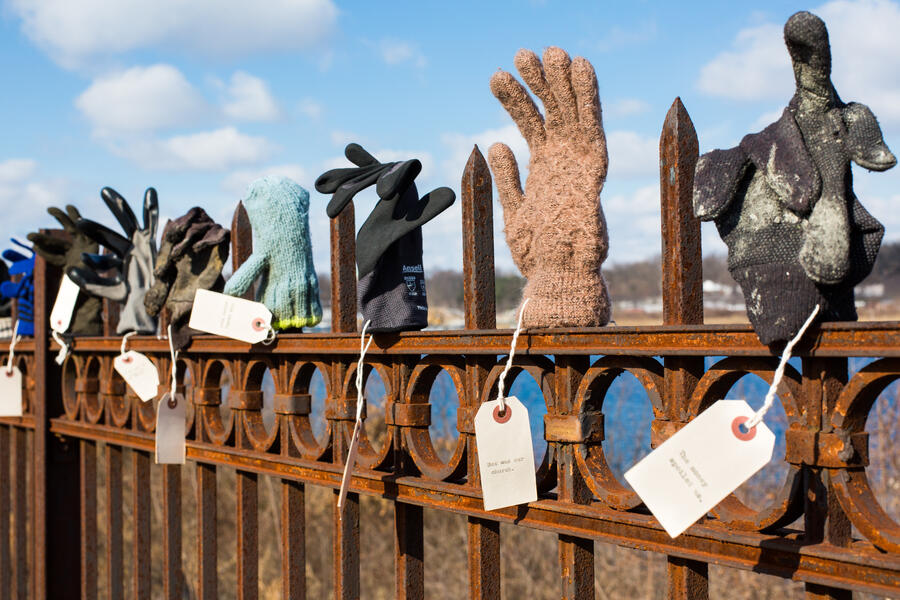 Library of Lost Gloves & Lost Loves
Library of Lost Gloves & Lost Loves2022
Found gloves, hang tags, signage
Location: Baltimore, MD -
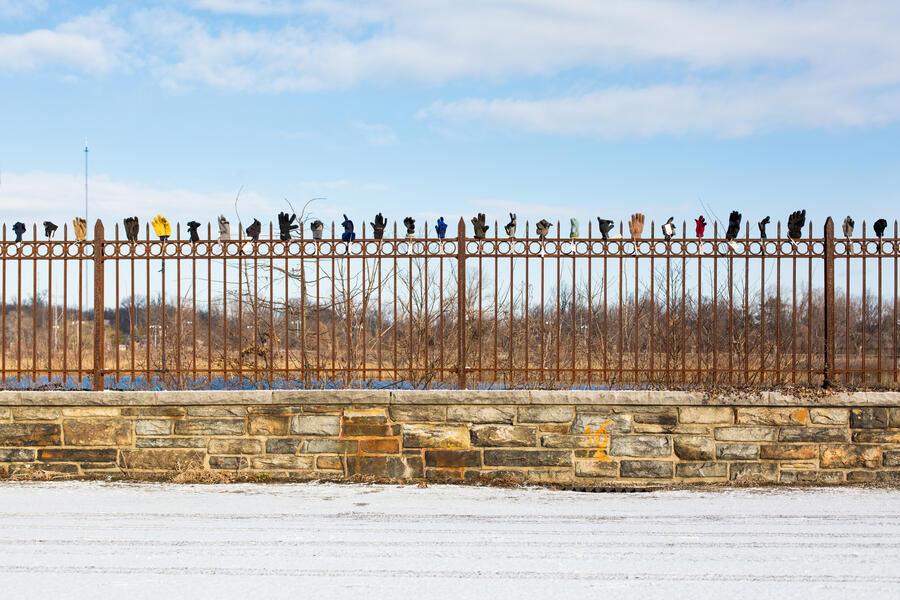 Library of Lost Gloves & Lost Loves
Library of Lost Gloves & Lost Loves2022
Found gloves, hang tags, signage
Location: Baltimore, MD -
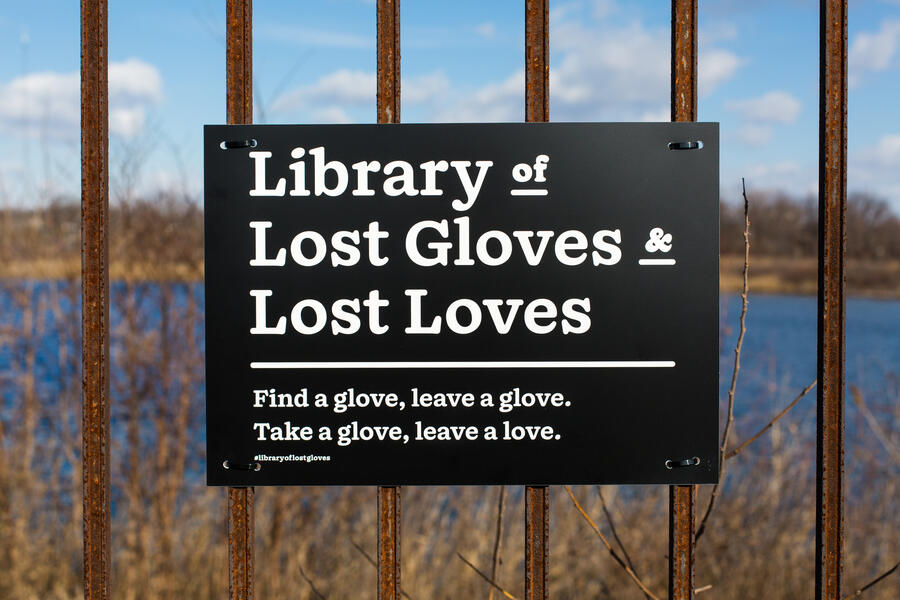 Library of Lost Gloves & Lost Loves
Library of Lost Gloves & Lost Loves2022
Found gloves, hang tags, signage
Location: Baltimore, MD -
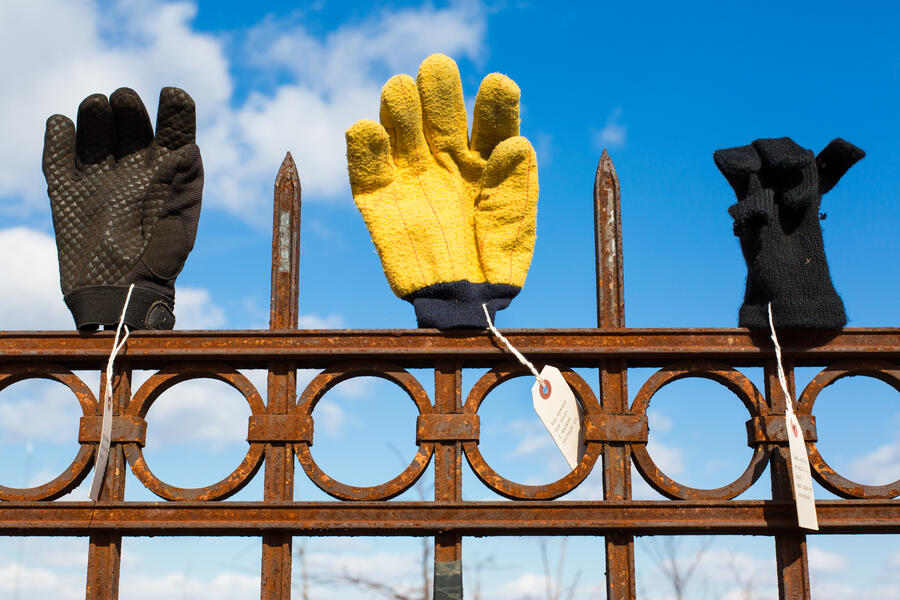 Library of Lost Gloves & Lost Loves
Library of Lost Gloves & Lost Loves2022
Found gloves, hang tags, signage
Location: Baltimore, MD -
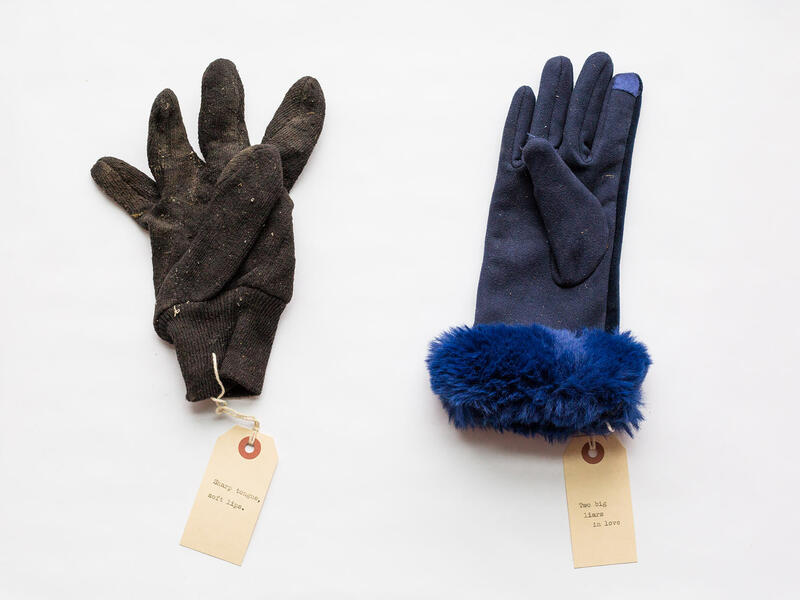 Library of Lost Gloves & Lost Loves
Library of Lost Gloves & Lost Loves2022
Found gloves, hang tags, signage
Location: Baltimore, MD -
 Library of Lost Gloves & Lost Loves
Library of Lost Gloves & Lost Loves2022
Found gloves, hang tags, signage
Location: Baltimore, MD -
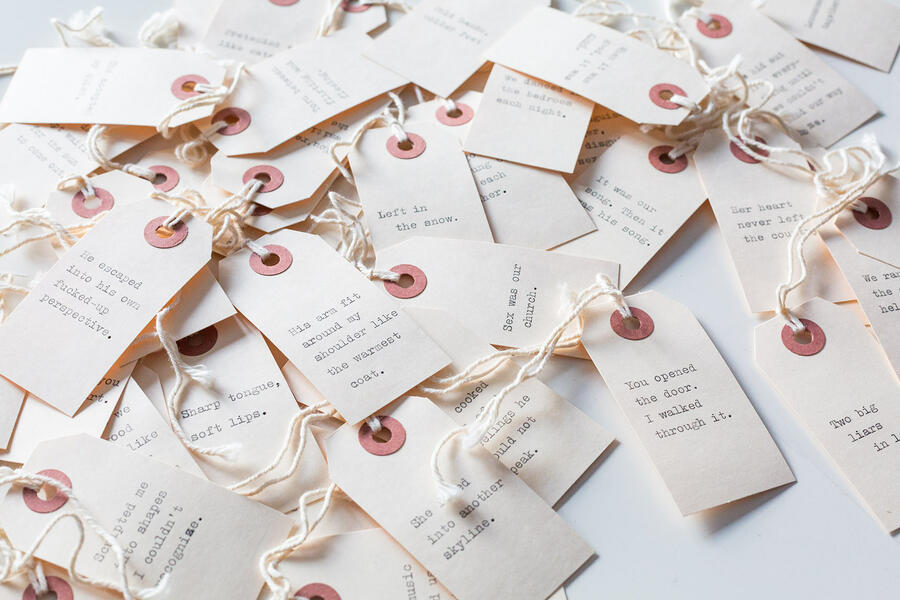 Library of Lost Gloves & Lost Loves
Library of Lost Gloves & Lost Loves2022
Found gloves, hang tags, signage
Location: Baltimore, MD -
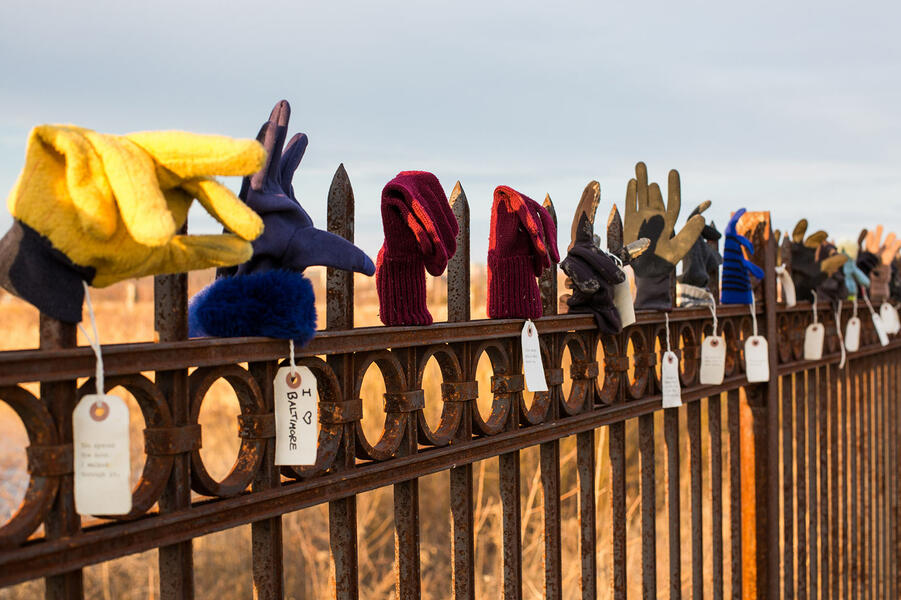 Library_of_Lost_Gloves-Bruce_Willen-BG6A1921.jpg
Library_of_Lost_Gloves-Bruce_Willen-BG6A1921.jpg2022
Found gloves, hang tags, signage
Location: Baltimore, MD
The Necessity of Tomorrow(s)
Can art and design carry a conversation beyond the walls of a lecture hall? Can it create richer context for the event itself? Can it spark new dialog and debate?
These were some of the questions discussed with the Baltimore Museum of Art for The Necessity of Tomorrow(s), a high-profile BMA lecture series on art, race, and social justice, featuring prominent black artists like Mark Bradford, Ta-Nehisi Coates, and Mickalene Thomas.
To help bring themes from the lecture series into public spaces around Baltimore, I led the creation of a series of detournéments — public art interventions that interrupt vernacular advertising and signage with hopeful expressions of “Tomorrow…” By injecting these little surreal moments into the public realm, we aimed to spark further questions and conversations related to The Necessity of Tomorrow(s).
Project team: Bruce Willen, Nolen Strals, Kacie Moon, Christian Mortlock, Seth Labenz, Roy Rub
Collaborators: BMA, Gamynne Guillotte, Kevin Zweerink, Gilah Press, Sage Screenprinting, Alpha Graphics, Dave Zimmerman
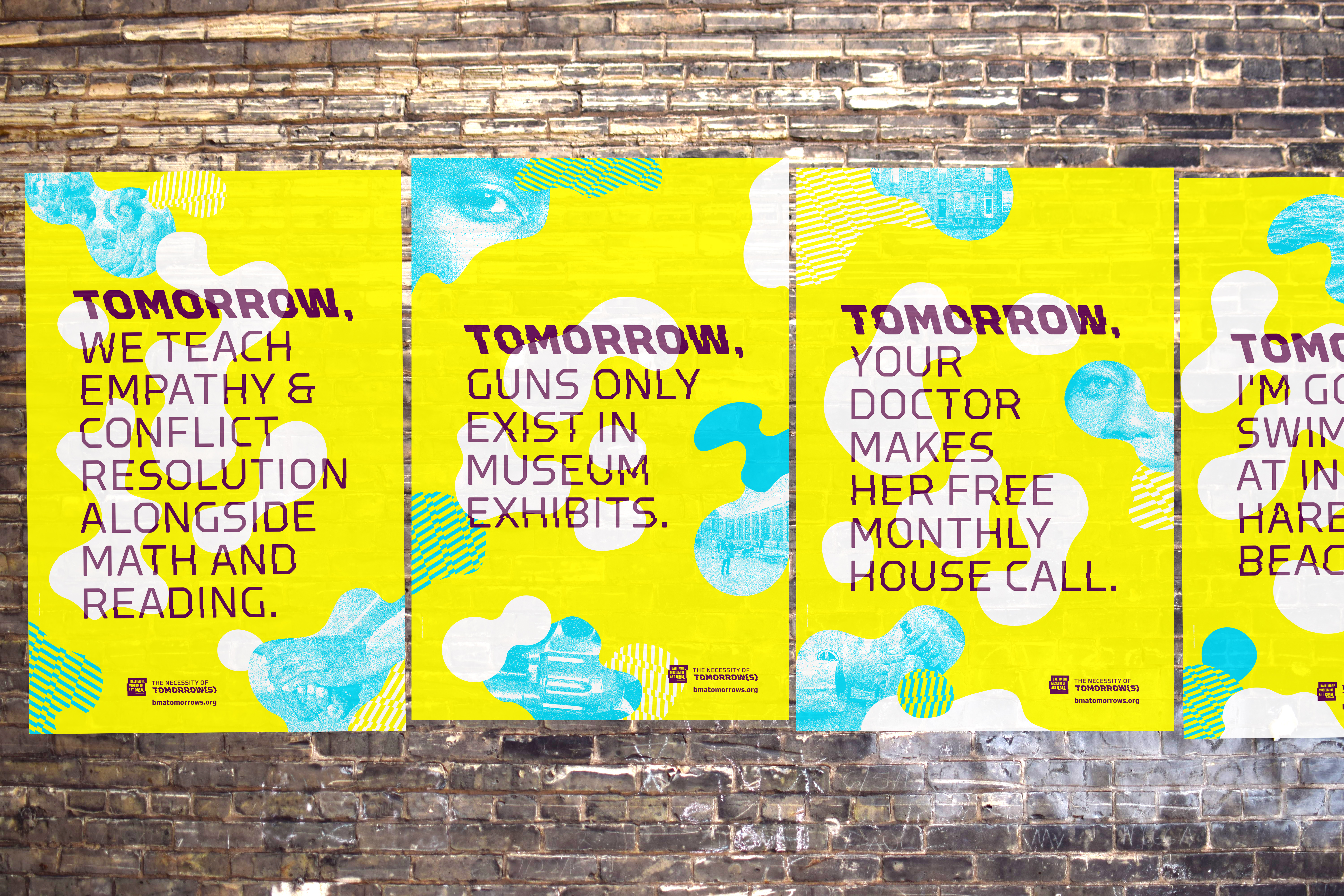
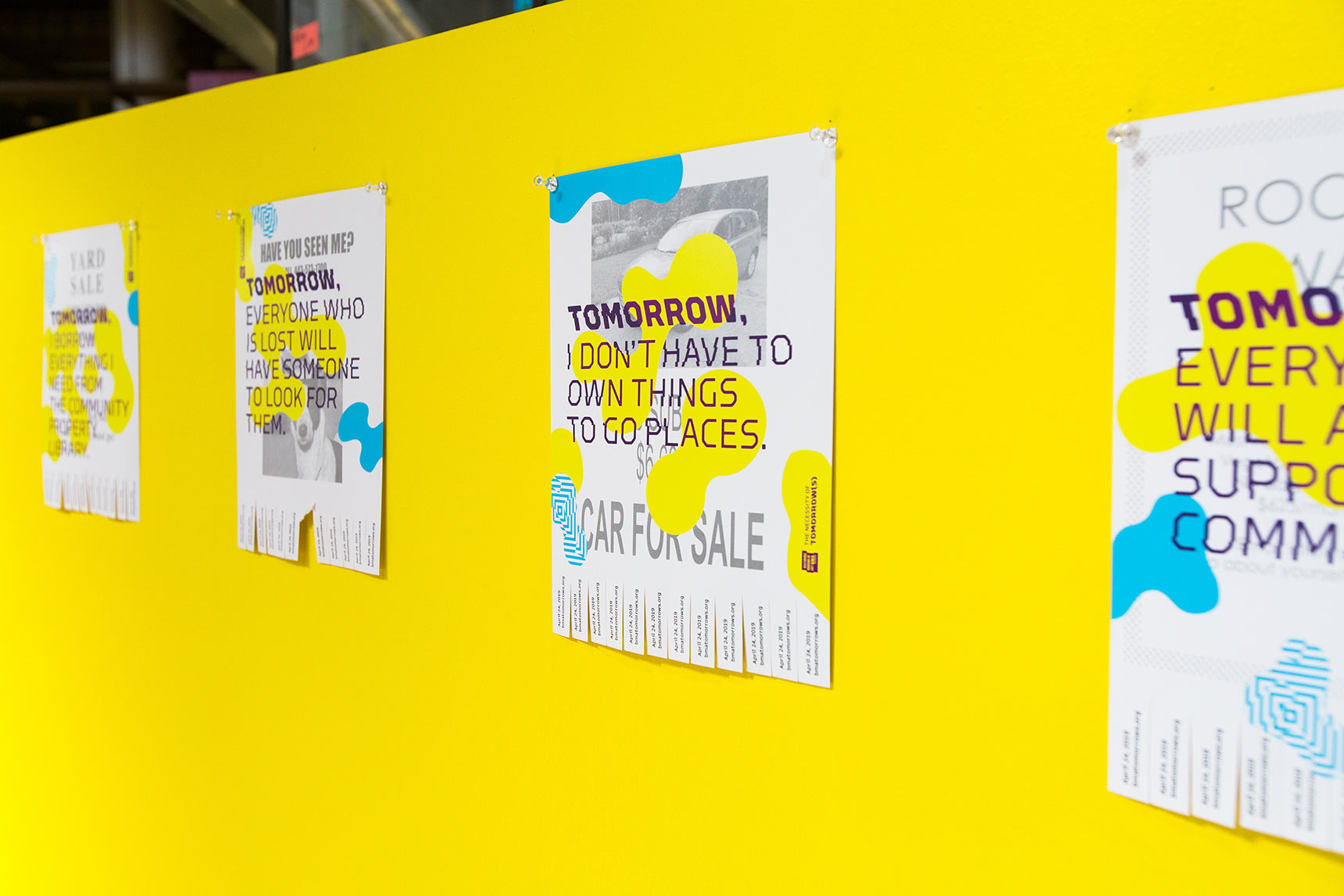
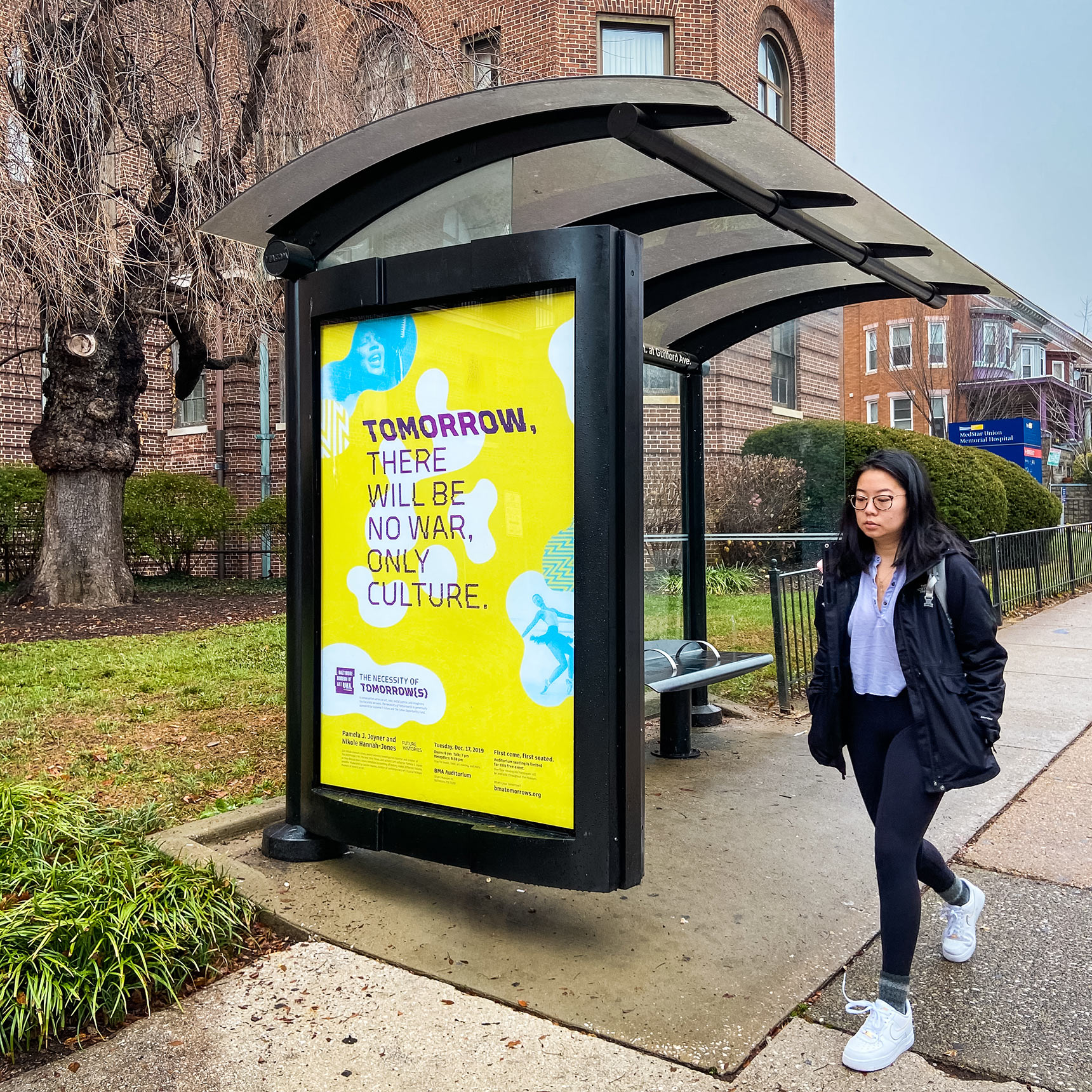
-
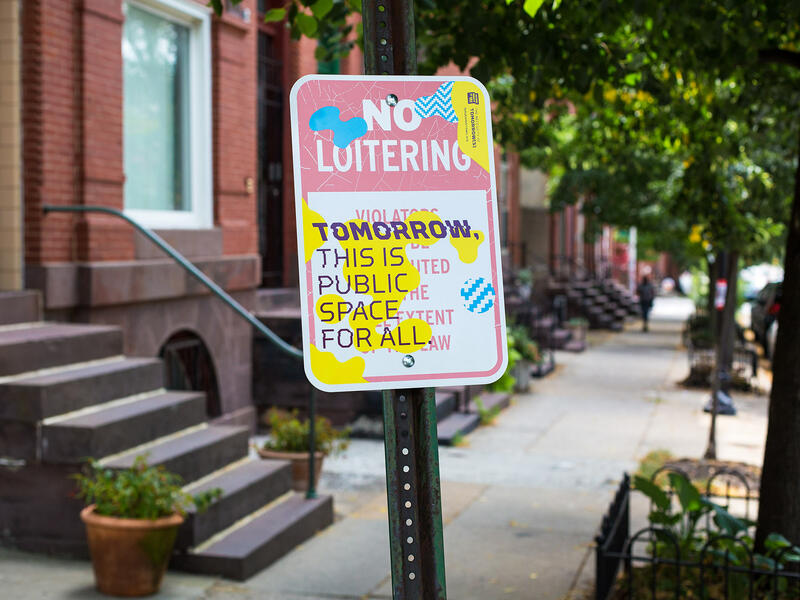 Tomorrow, this is public space for all.
Tomorrow, this is public space for all.2018
Screenprinted aluminum sign, stainless steel hardware -
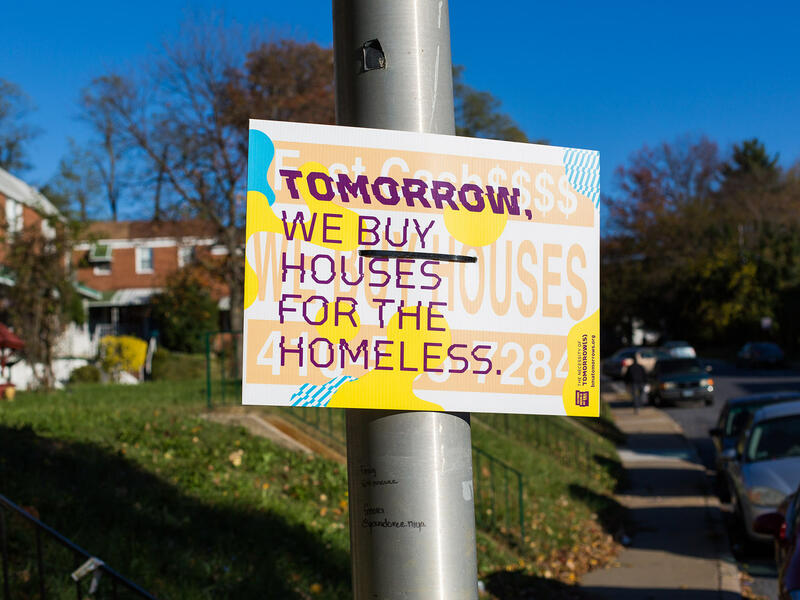 BMA.Tomorrows_We_Buy_Houses1_crop_1.jpg
BMA.Tomorrows_We_Buy_Houses1_crop_1.jpg2018
Screenprinted sign, zip ties -
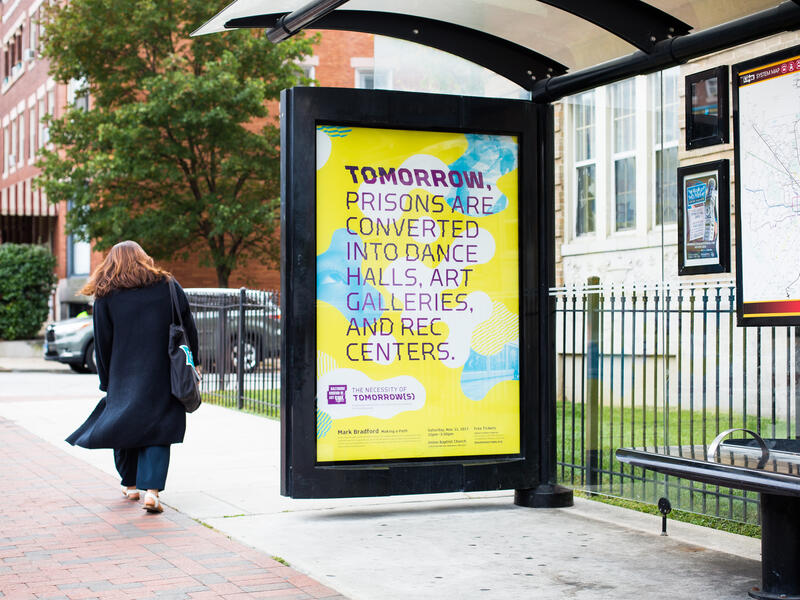 BMA.Tomorrows_Bus_shelter3.jpg
BMA.Tomorrows_Bus_shelter3.jpg2017
Digitally printed transit ad poster -
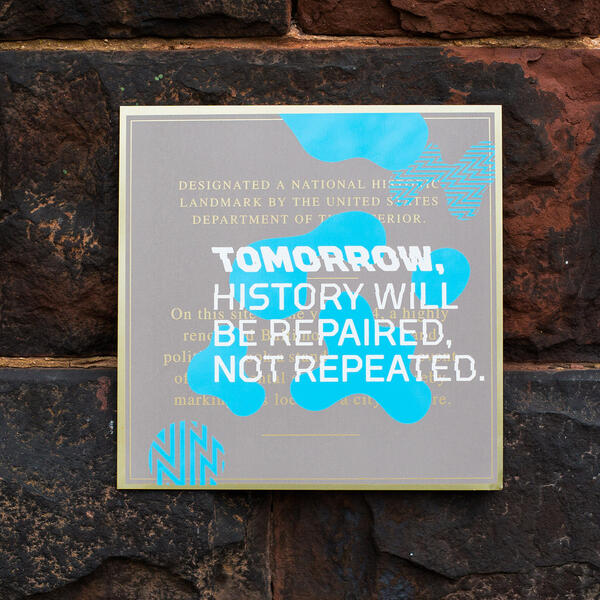 Tomorrow, history will be repaired, not repeated.
Tomorrow, history will be repaired, not repeated.2019
Screenprinted brass plaque -
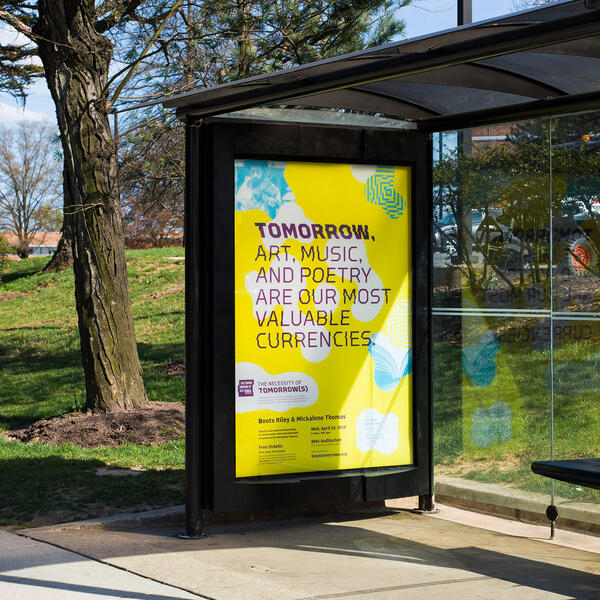 Tomorrow, art, music, and poetry are our most valuable currencies. (transit ad)
Tomorrow, art, music, and poetry are our most valuable currencies. (transit ad)2018
Digitally printed transit ad poster -
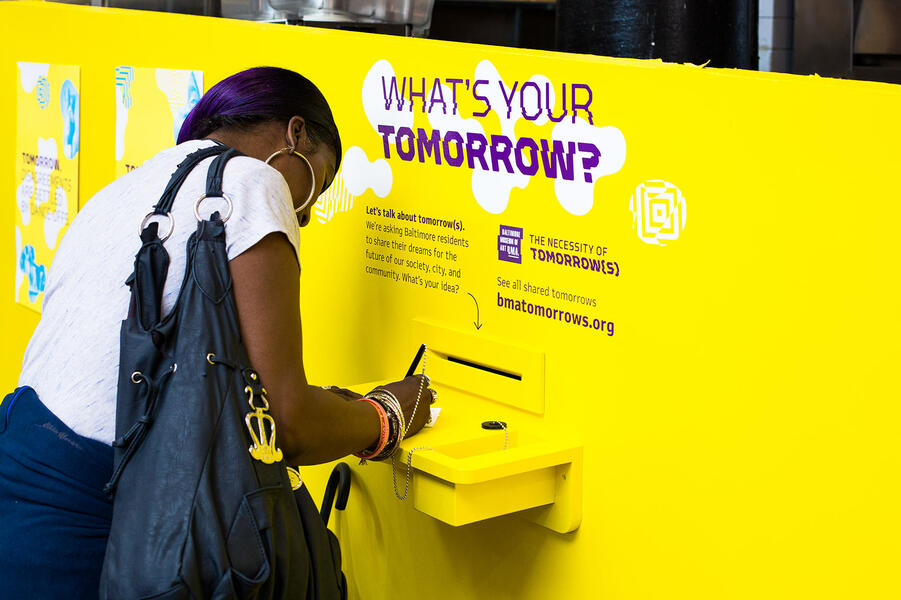 Sharing ideas for tomorrow(s) at Lexington Market
Sharing ideas for tomorrow(s) at Lexington Market2019
Digital prints on paper, paint, wood, vinyl graphics
(Detail from installation at Lexington Market) -
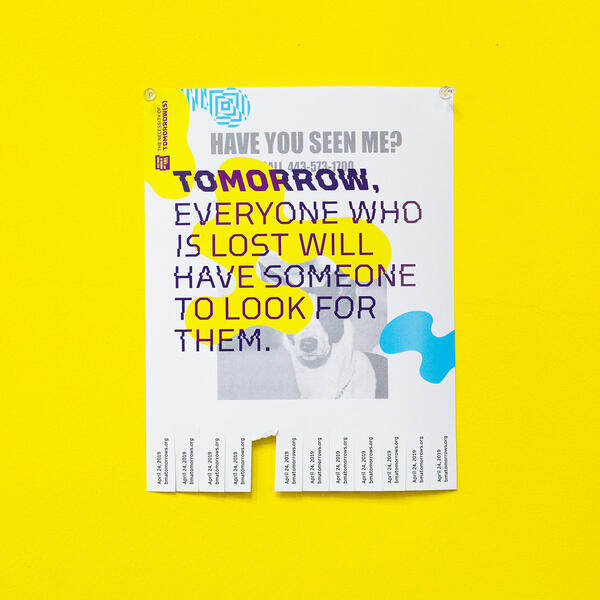 Tomorrow, everyone who is lost will have someone to look for them. (installation detail)
Tomorrow, everyone who is lost will have someone to look for them. (installation detail)2019
Digital prints on paper
(Detail from installation at Lexington Market) -
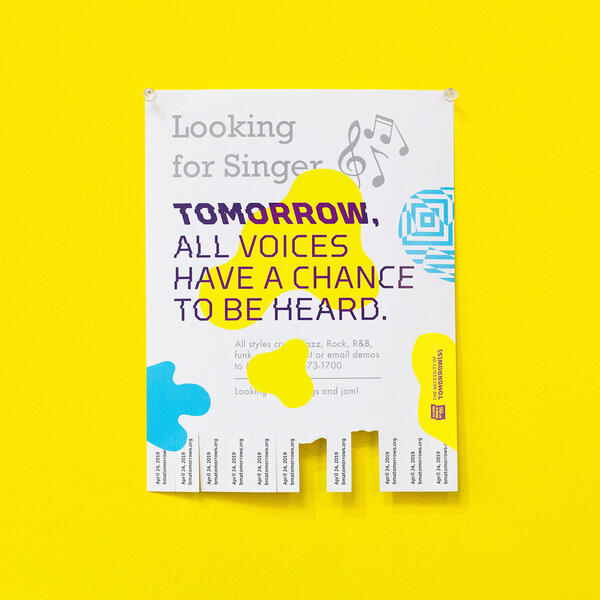 BMA.Tomorrows_flyer2_0.jpg
BMA.Tomorrows_flyer2_0.jpg2019
Digital prints on paper
(Detail from installation at Lexington Market) -
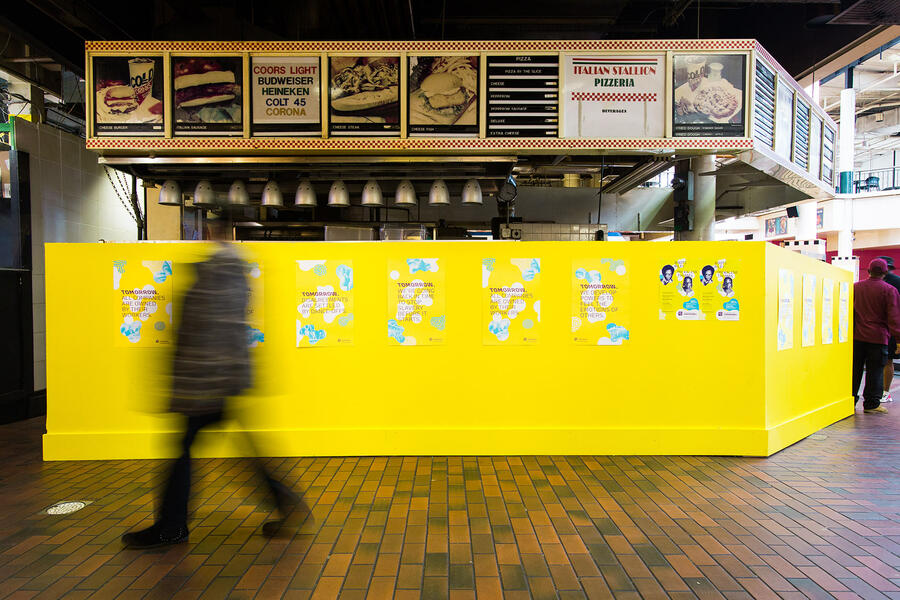 BMA.Tomorrows_poster_installation4.jpg
BMA.Tomorrows_poster_installation4.jpg2019
Digital prints on paper
(Detail from installation at Lexington Market) -
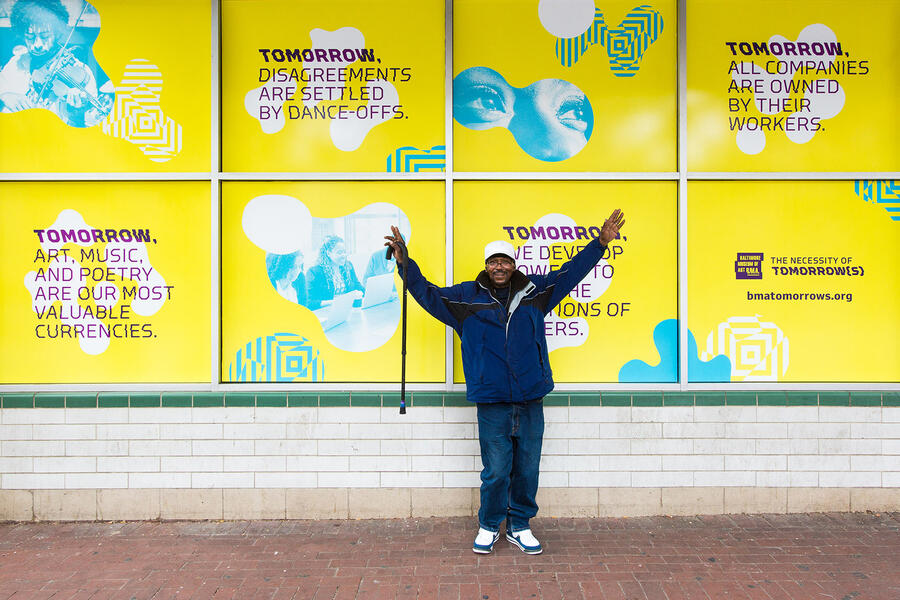 Installation at Lexington Market (detail of exterior windows)
Installation at Lexington Market (detail of exterior windows)2019
Printed vinyl
Ghost Stoops
Glowing portals mark the former sites of demolished rowhomes in Baltimore
Baltimore’s city grid is interrupted with thousands of empty lots that once contained rowhouses, homes to generations of residents, rich and poor alike, who once congregated on the vanished front stoops. Like missing teeth the sites of these demolished buildings are a palpable absence in the neighborhood fabric.
Ghost Stoops proposes to revivify and memorialize these missing homes and memories. Marble steps, framed by glowing outlines recall the houses that once stood at these sites.
2020
Steel, LED neon lighting, stone steps
Auto Repair (installation proposals for restored human landscapes)
A series of speculative installations that touch on car branding, capitalist mythologies, and Anthropocene-age landscapes
Within this series Toyota Tundras, Sequoias, GMC Denalis, Acadias, Chevrolet Suburbans, and others become containers for restored landscapes, the flora, and habitats for which they are named — broken and crushed, perhaps by the weight of their own irony.
2024
C-prints of digital renderings
20 x 20 inches each
Broken Windows
Selected images from an ongoing photo series
2003–present
Color photography
-
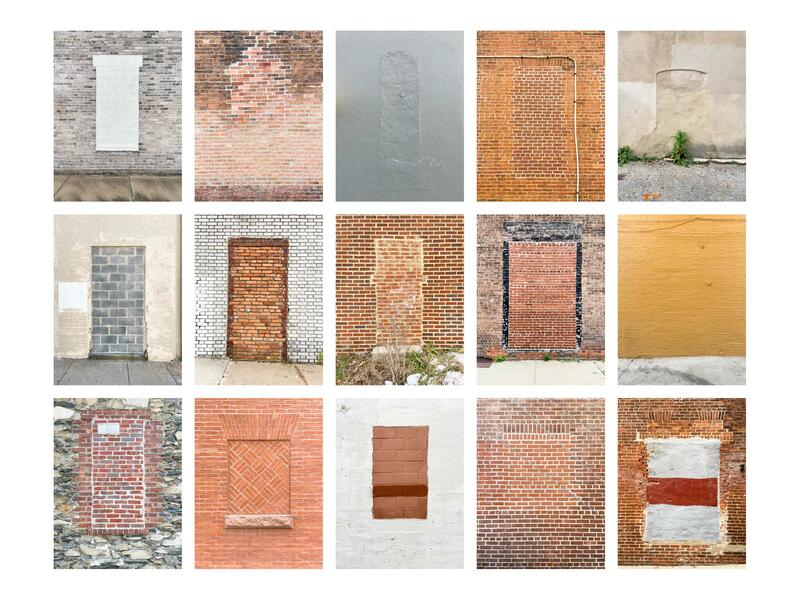 Broken Windows
Broken WindowsSelection from an ongoing series
2003–present
Color photography -
 Broken Window 3368
Broken Window 3368Selection from an ongoing series
2003–present
Color photography -
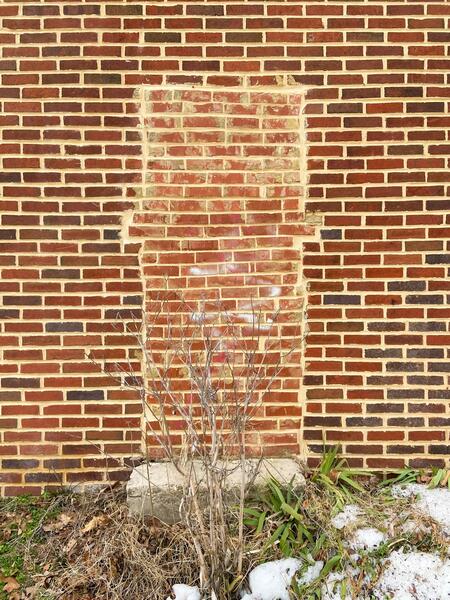 Broken Window
Broken WindowSelection from an ongoing series
2003–present
Color photography -
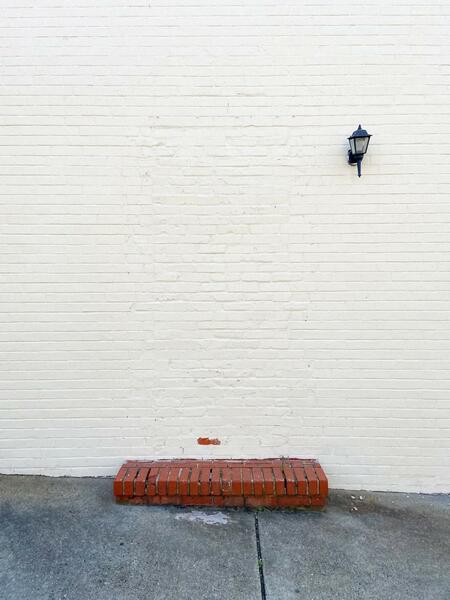 Broken Window 2574
Broken Window 2574Selection from an ongoing series
2003–present
Color photography -
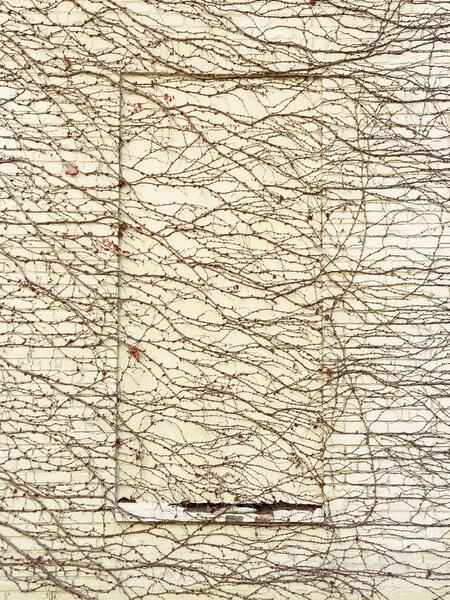 Broken Window 9905
Broken Window 9905Selection from an ongoing series
2003–present
Color photography -
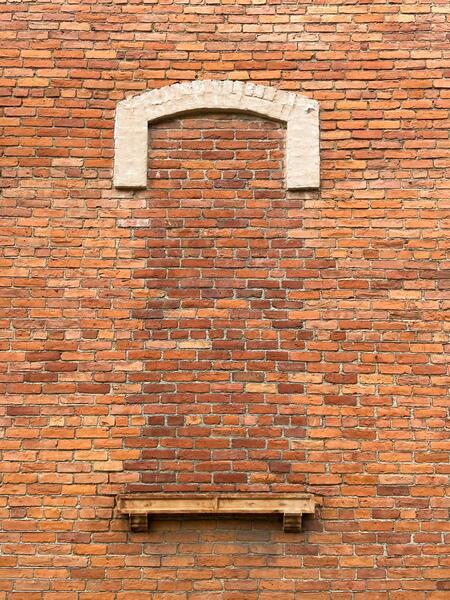 Broken Window 1696
Broken Window 1696Selection from an ongoing series
2003–present
Color photography -
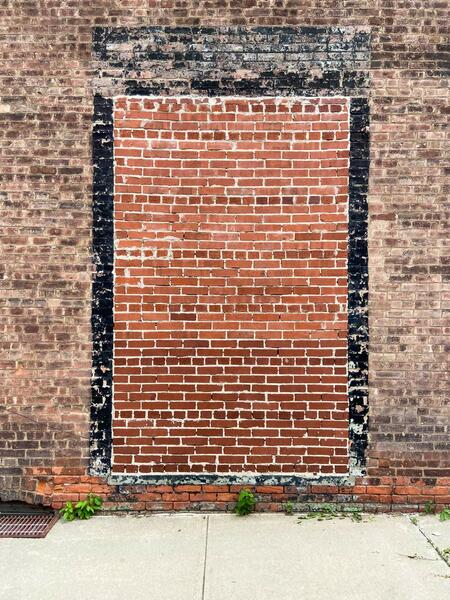 Broken Window 1464
Broken Window 1464Selection from an ongoing series
2003–present
Color photography -
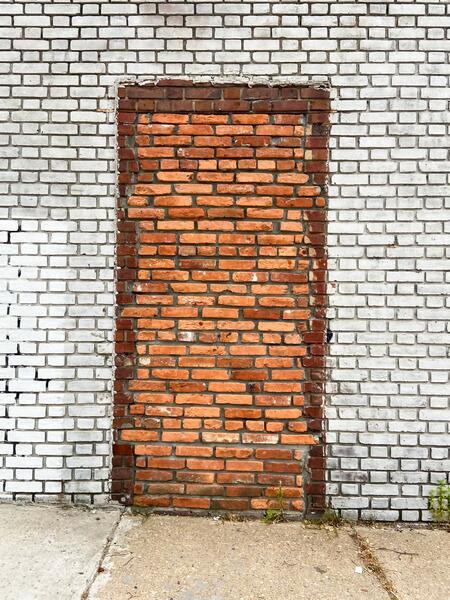 Broken Window 8262
Broken Window 8262Selection from an ongoing series
2003–present
Color photography -
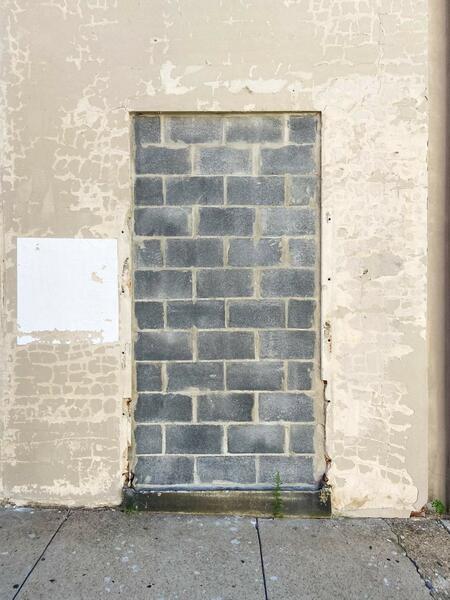 Broken Window 8767
Broken Window 8767Selection from an ongoing series
2003–present
Color photography -
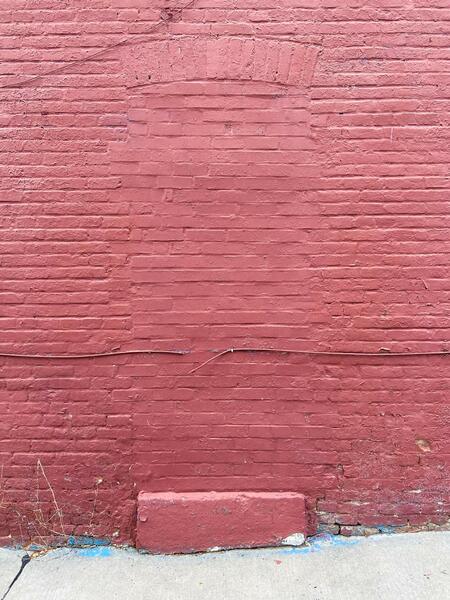 Broken Window 8156
Broken Window 8156Selection from an ongoing series
2003–present
Color photography
Public Park
An art action to activate a vacant lot and interrogate the practice of land banking
Public Park temporarily reclaimed a large fenced-off lot in the heart of Charles Village as a public space. This guerilla art and placemaking action activated this long-vacant land for the first time in many years, while calling attention to the practice of institutional land banking.
In cities like Baltimore, where real estate is relatively affordable, it’s common practice for investors to “land bank,” buying vacant property and holding onto it for years or decades, allowing the buildings and lots to fall into disrepair while preventing improvements or productive use. At large scale, land banking obstructs community revitalization efforts. Institutions and municipal agencies are often just as culpable as out-of-town slumlords.
2011
Art action, hand-painted sign
Location: Baltimore, MD
Collaborators: Nolen Strals
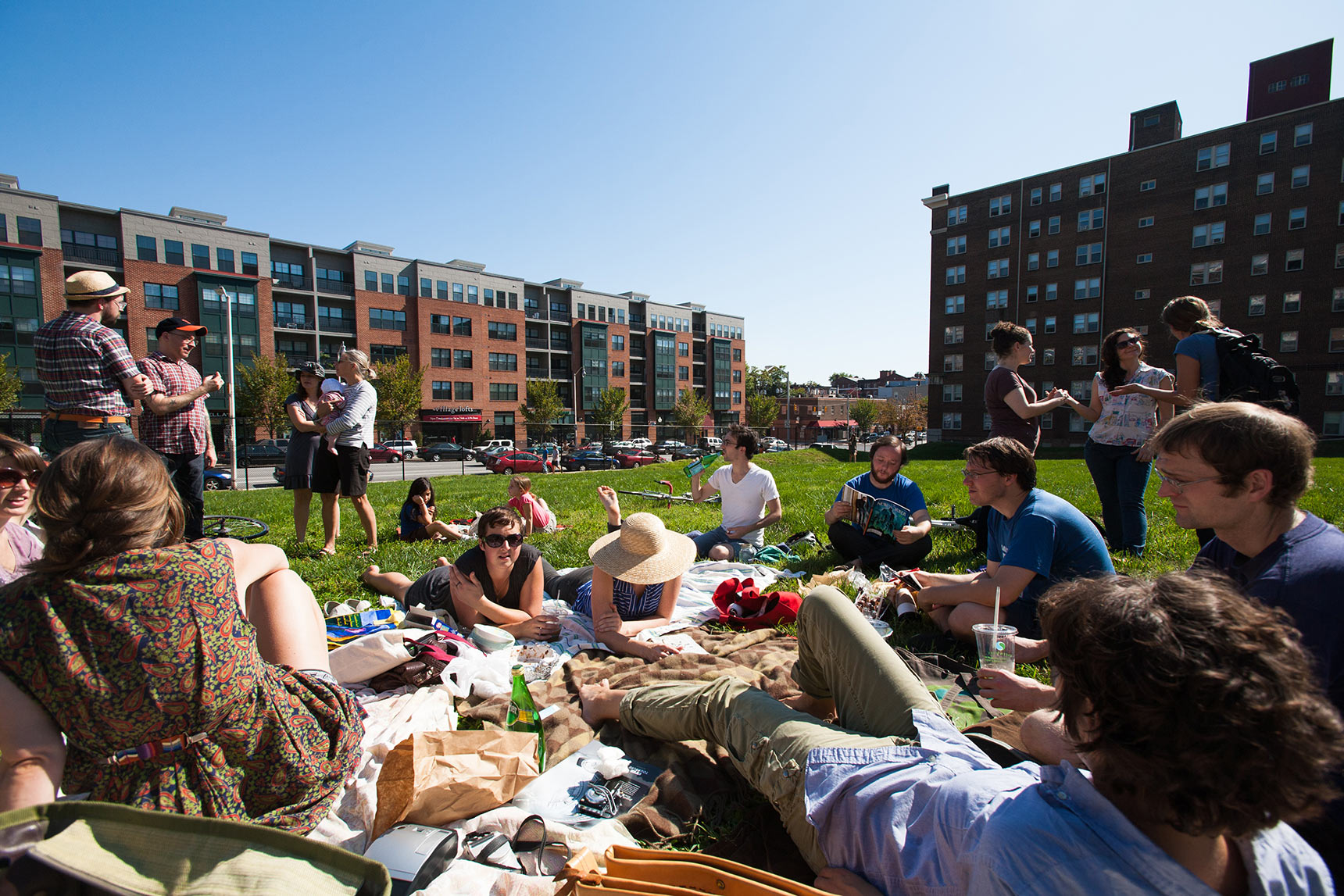
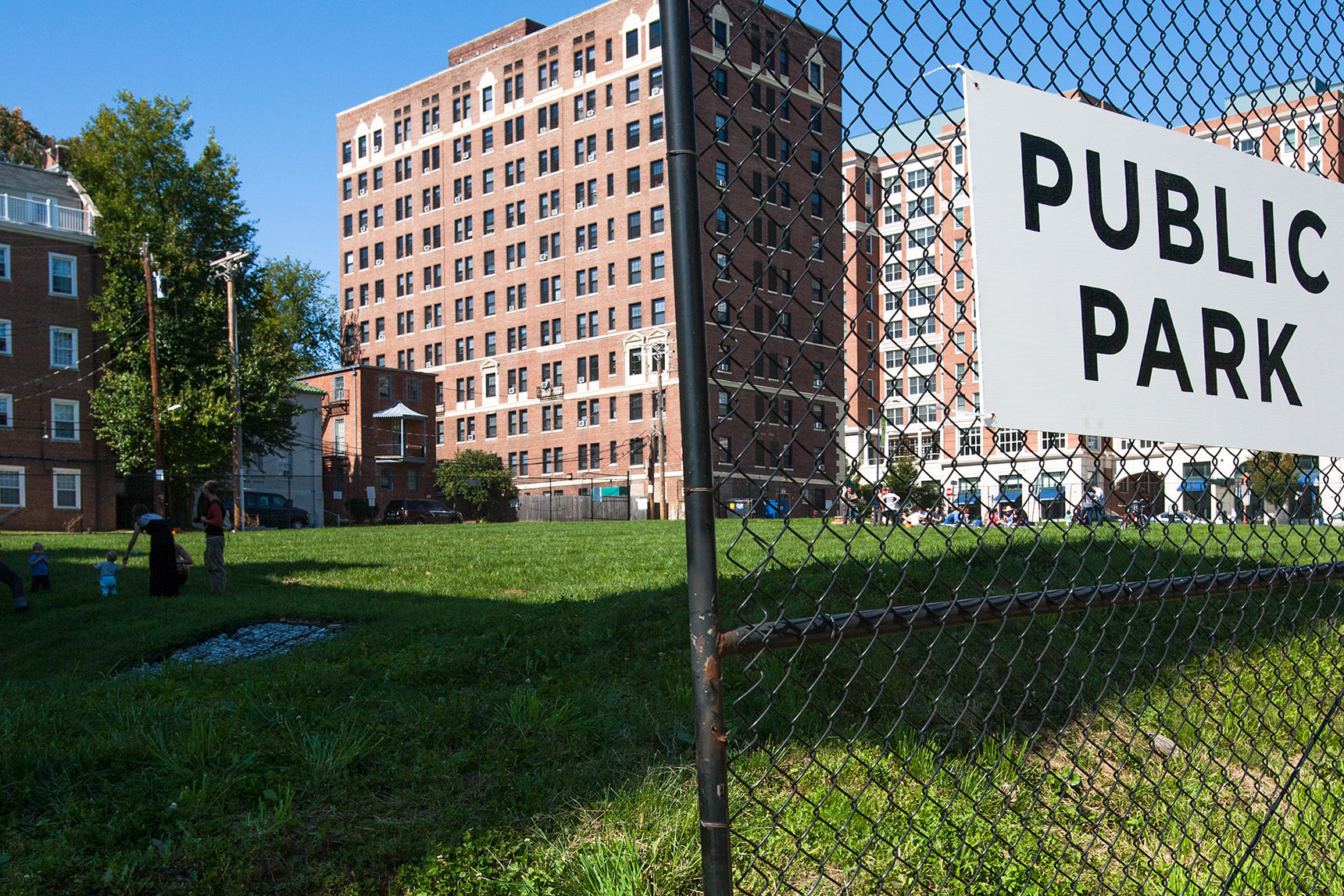
-
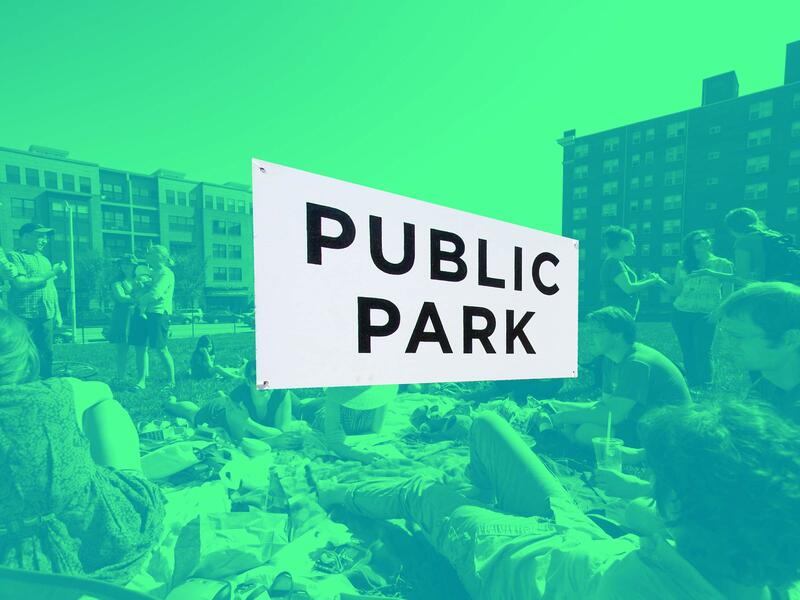 Public Park
Public Park2011
Art action, hand-painted sign
Location: Baltimore, MD -
Public Park
2011
Art action, hand-painted sign
Location: Baltimore, MD -
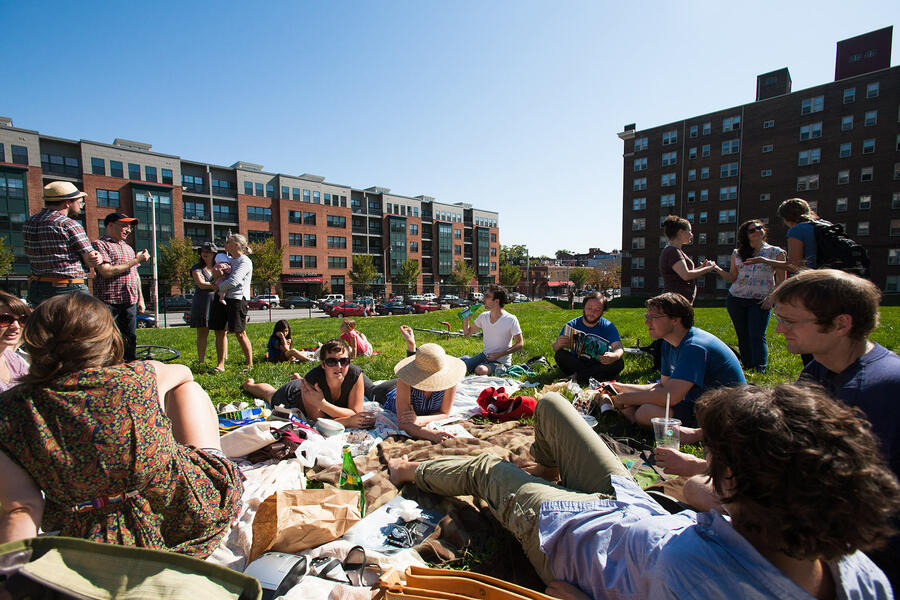 Public Park
Public Park2011
Art action, hand-painted sign
Location: Baltimore, MD -
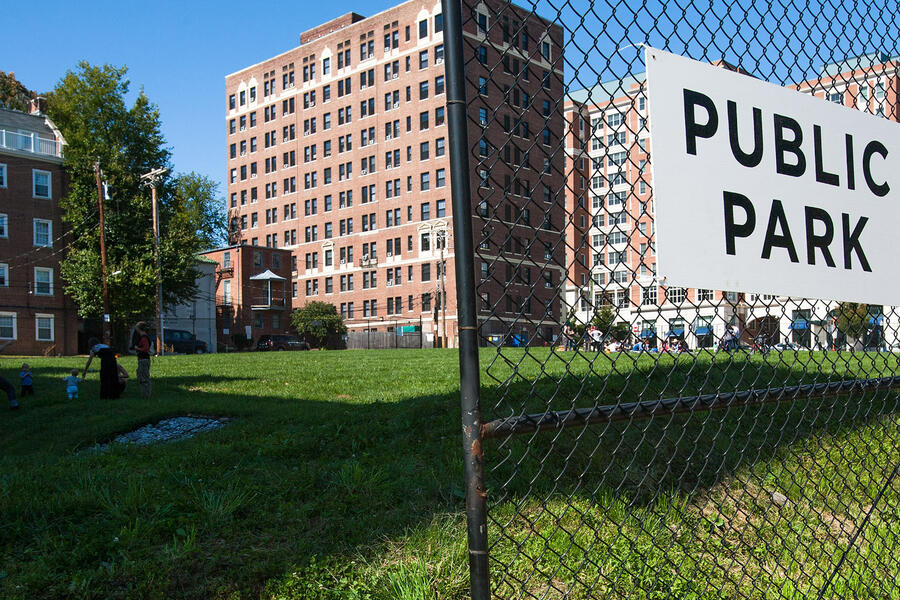 Unlocking the gate to create Public Park
Unlocking the gate to create Public Park2011
Art action, hand-painted sign
Location: Baltimore, MD -
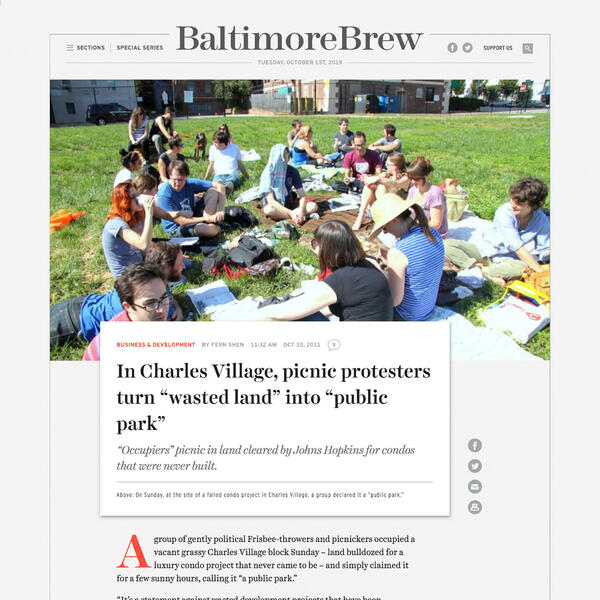 Media coverage of Public Park
Media coverage of Public Park -
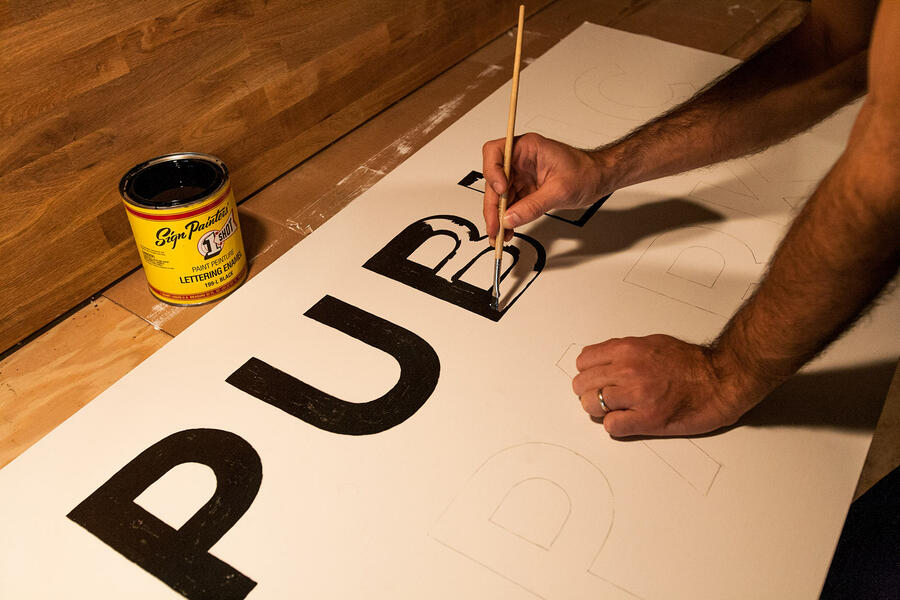 Hand-painting Public Park signage
Hand-painting Public Park signagePainting the sign for Public Park, an art action to activate a fenced-off lot and interrogate the practice of land banking.
-
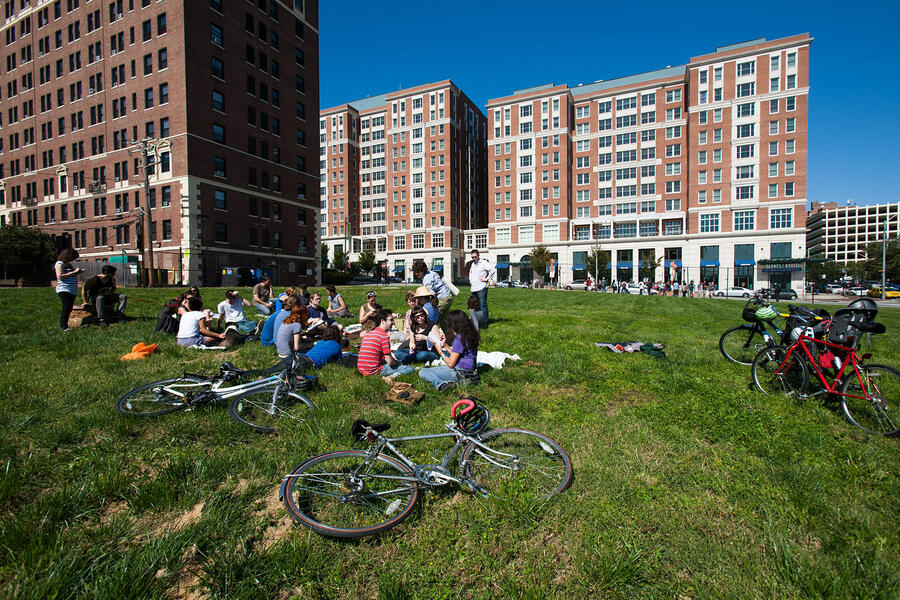 Public Park
Public Park2011
Art action, hand-painted sign
Location: Baltimore, MD
Codependent Chair
Found object sculpture
2019
Salvaged three-legged chair, rock
Dimensions: 18 x 21 x 32”
-
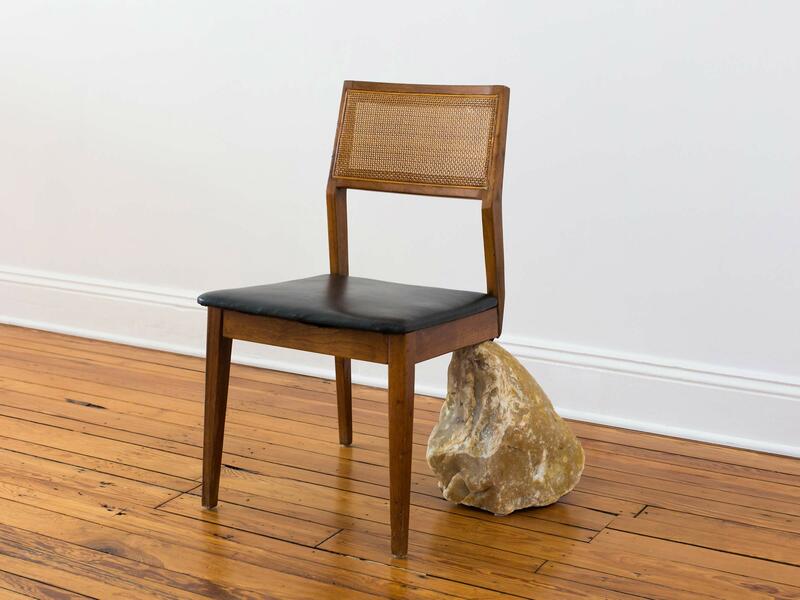 Codependent Chair
Codependent Chair2019
Found three-legged chair, rock
Dimensions: 18 x 21 x 32” -
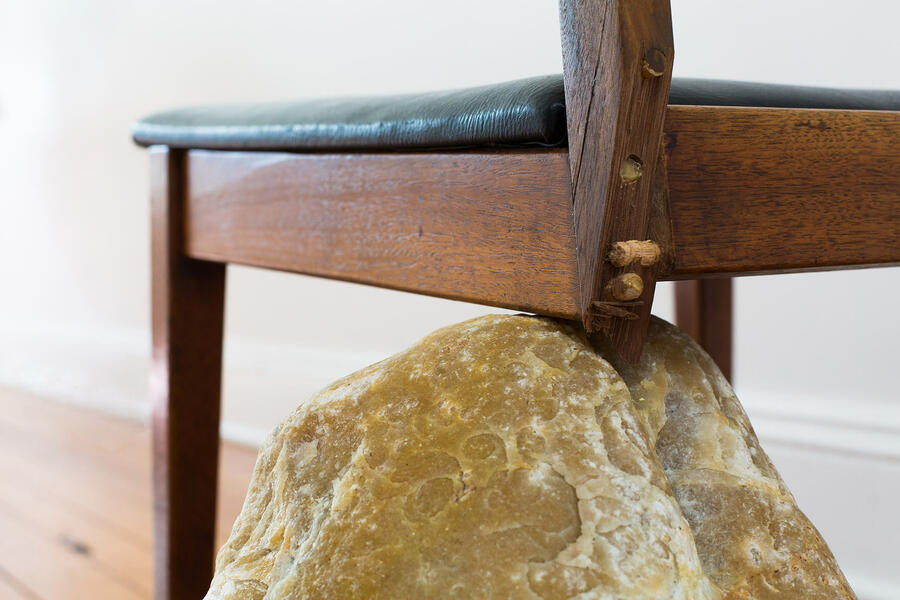 Codependent Chair (detail)
Codependent Chair (detail)2019
Found three-legged chair, rock
Dimensions: 18 x 21 x 32” -
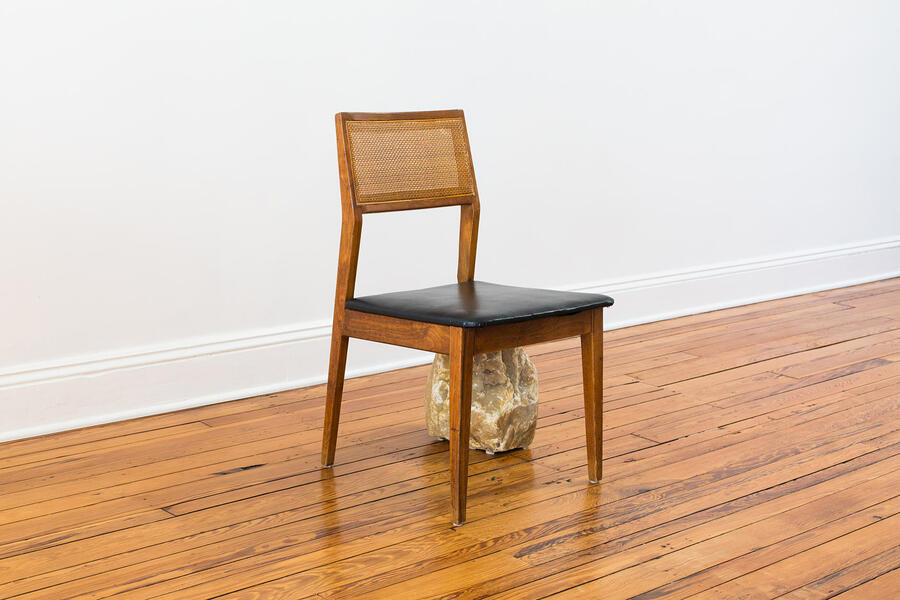 Codependent Chair
Codependent Chair2019
Found three-legged chair, rock
Dimensions: 18 x 21 x 32” -
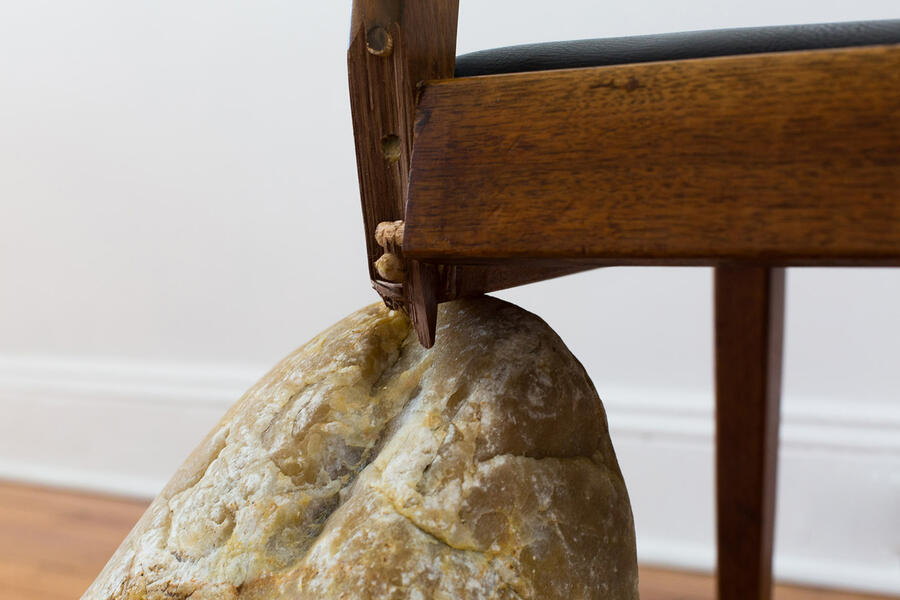 Codependent Chair (detail)
Codependent Chair (detail)2019
Found three-legged chair, rock
Dimensions: 18 x 21 x 32”
OSAYCANYOUSEE
Prints and objects inspired by the War of 1812 bicentennial
OSAYCANYOUSEE was solo exhibition by Bruce Willen and Nolen Strals, featuring prints and objects inspired by the War of 1812. Though lesser-known today, this first truly American war shaped our national identity and set the tone for the country’s westward expansion and the development of the American psyche over the next two centuries.
The artwork in the exhibition incorporates themes of capitalism, violence, and baseball with visual wit, dark humor, and a bold graphic aesthetic, drawing iconography from pop culture, patriotism, and American history. Each piece takes its title from lyrics to “The Star-Spangled Banner”—appropriately referencing the song penned two hundred years ago in the Baltimore harbor. The work ranges from austere, graphic images to intense, illustrative work inspired by pop psychedelia. Each piece is layered with innuendo and symbolism, inviting the viewer to look and read more closely.
2012
Selection of editions shown here includes:
Serigraph prints
Engraved baseball bat
Letterpress editions
Letterpress monoprint
Collaborator: Nolen Strals
-
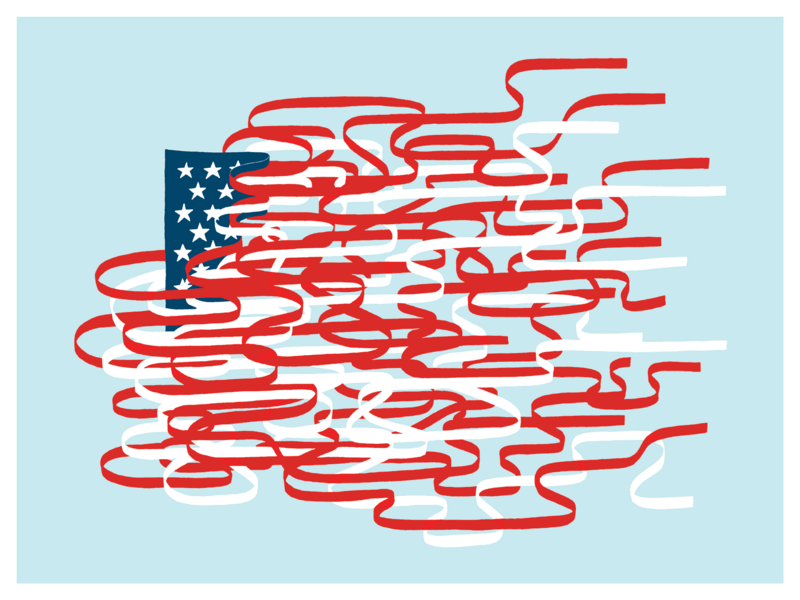 Through the Perilous Fight
Through the Perilous Fight2012
3-color serigraph print, edition of 50
Dimensions: 24 x 18″ -
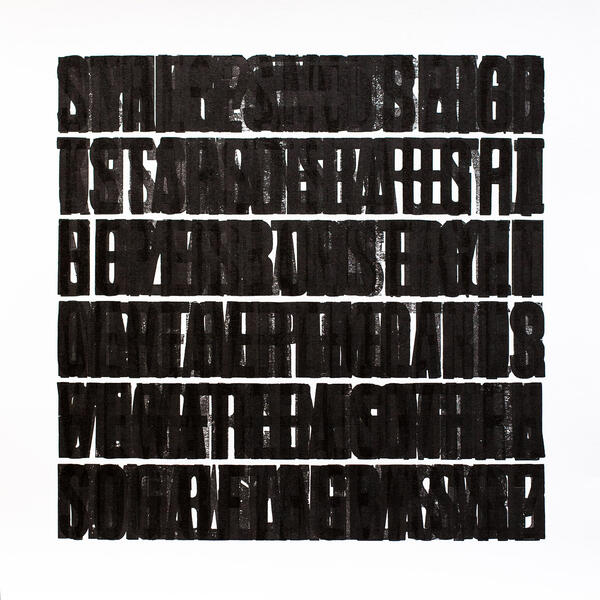 Star Spangled Banner (Half Conceals, Half Discloses)
Star Spangled Banner (Half Conceals, Half Discloses)2012
Letterpress monoprint
Dimensions: 19.5 x 19.5”
Overprinted lyrics to the national anthem printed with wood type from the Globe at MICA collection, on acid-free cotton paper -
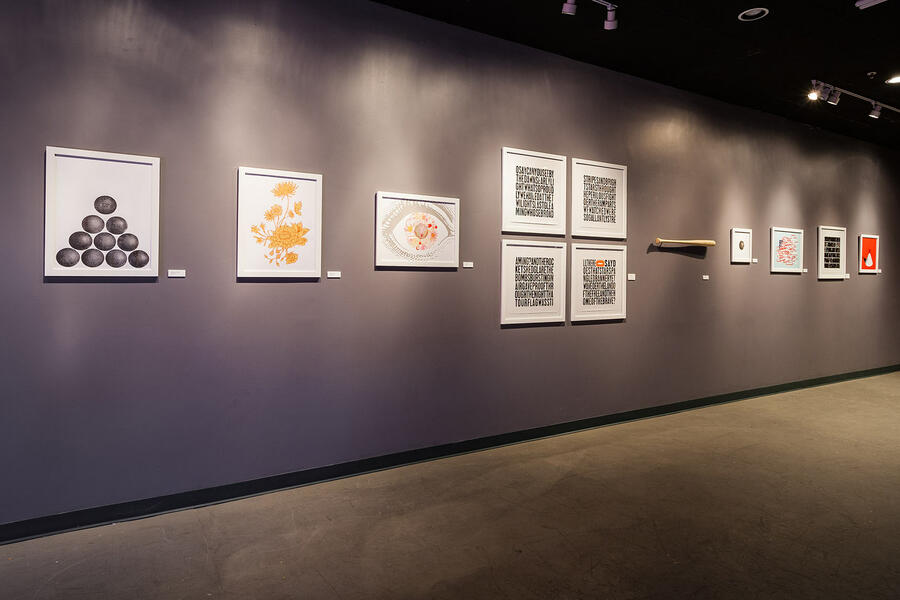 OSAYCANYOUSEE installed in 2012
OSAYCANYOUSEE installed in 2012Installation view of some of the works in OSAYCANYOUSEE, prints and objects examining the legacy of the War of 1812
-
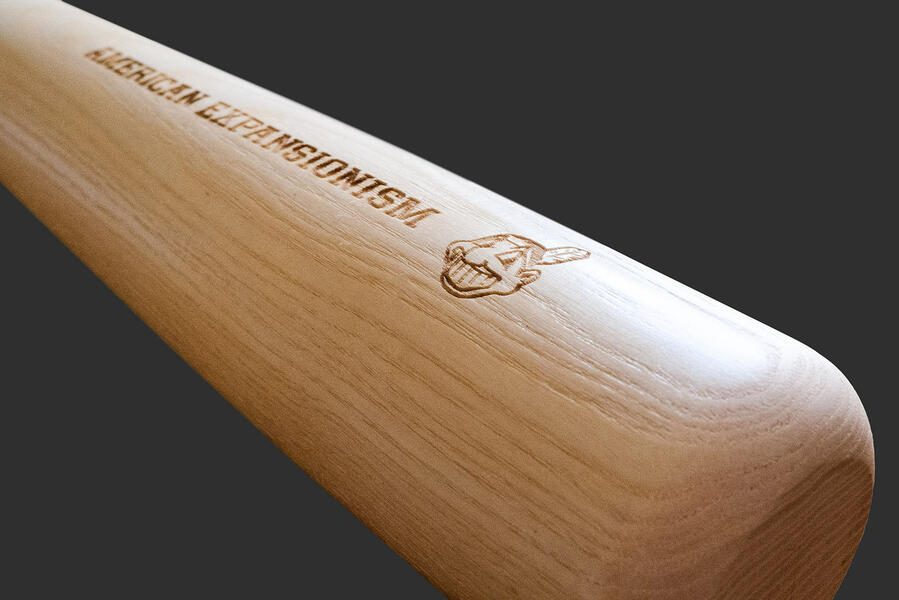 American Expansionism (detail)
American Expansionism (detail)2012
Engraved baseball bat, edition of 5
Dimensions: 34 x 3.5 x 3.5”"In 2020 the Cleveland Indians finally announced that the retirement of their racist 'Chief Wahoo' logo and the Indians name. (The team will keep selling Chief Wahoo 'throwback' merch in the shop however...) These engraved baseball bats were made for a 2012 exhibition that examined the War of 1812, a conflict that helped cement Manifest Destiny into an American ideology. Following the defeat of the British in 1814, America's expansionist policy officially sanctioned the violent 'settlement' of native lands in areas that include present day Ohio, Indiana, and Michigan. This expansionist ideology, much of it rooted in White supremacy, continued globally into the 21st century."
— Bruce
-
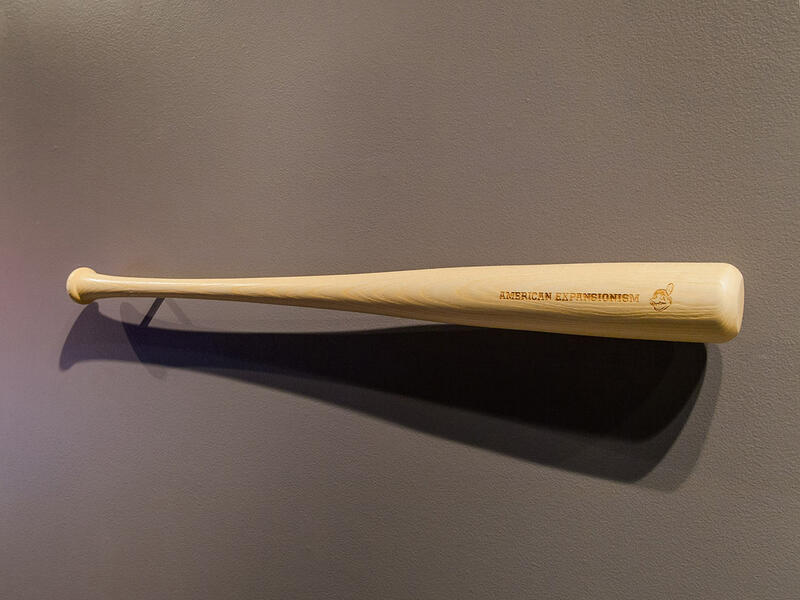 American Expansionism
American Expansionism2012
Engraved baseball bat, edition of 5
Dimensions: 34 x 3.5 x 3.5”"In 2020 the Cleveland Indians finally announced that the retirement of their racist 'Chief Wahoo' logo and the Indians name. (The team will keep selling Chief Wahoo 'throwback' merch in the shop however...) These engraved baseball bats were made for a 2012 exhibition that examined the War of 1812, a conflict that helped cement Manifest Destiny into an American ideology. Following the defeat of the British in 1814, America's expansionist policy officially sanctioned the violent 'settlement' of native lands in areas that include present day Ohio, Indiana, and Michigan. This expansionist ideology, much of it rooted in White supremacy, continued globally into the 21st century."
— Bruce
-
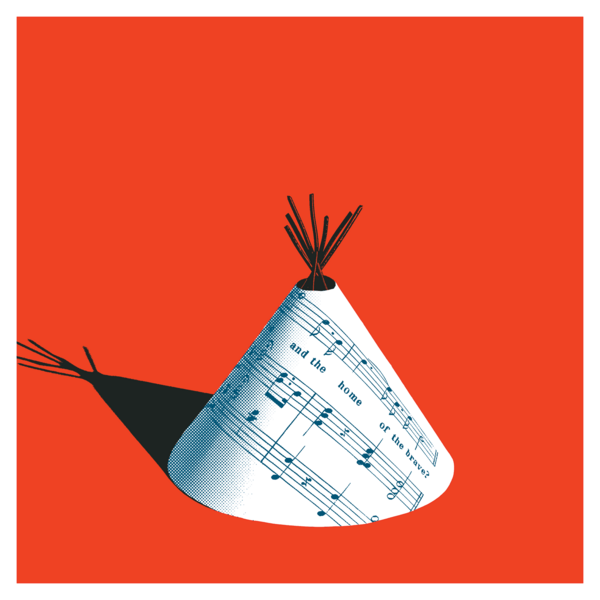 And the Home of the Brave?
And the Home of the Brave?2012
2-color serigraph print, edition of 50
Dimensions: 18 x 24″ -
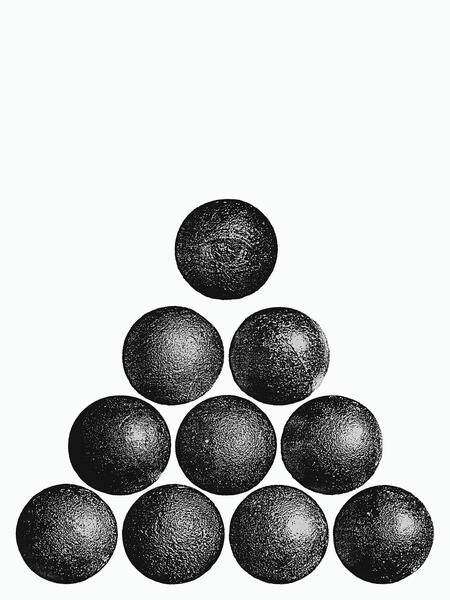 Twilight’s Last Gleaming
Twilight’s Last Gleaming2012
2-color serigraph print, edition of 50
Dimensions: 18 x 24″ -
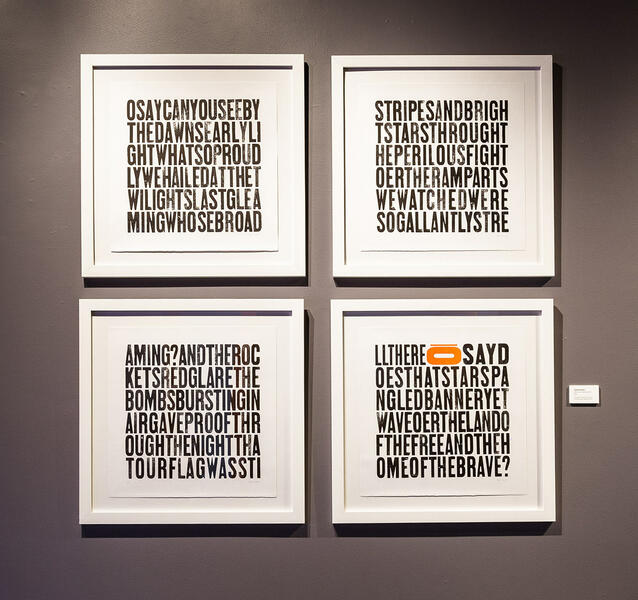 OSAYCANYOUSEE
OSAYCANYOUSEE2012
Set of 4 letterpress prints, signed edition of 15
Printed with wood type from the Globe at MICA collection, on acid-free cotton paper
Dimensions: each 19.5 x 19.5″ -
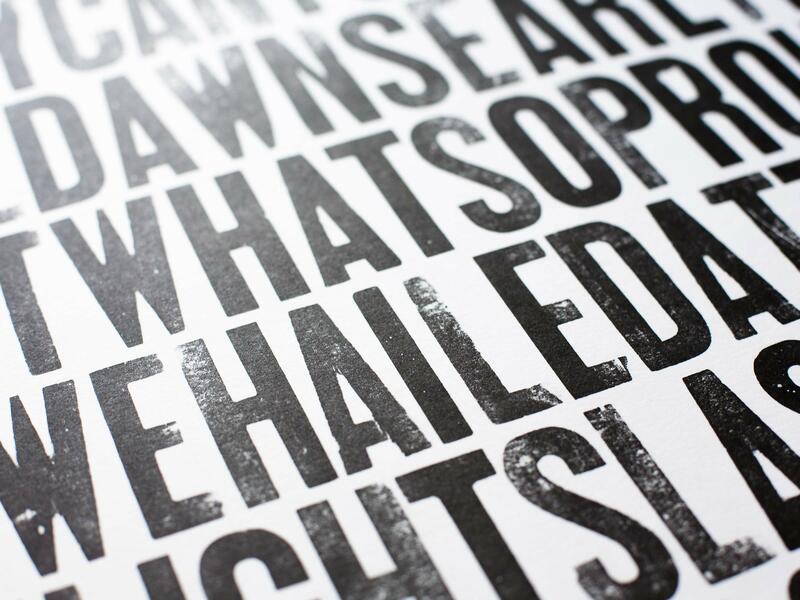 OSAYCANYOUSEE (detail)
OSAYCANYOUSEE (detail)2012
Set of 4 letterpress prints, signed edition of 15
Printed with wood type from the Globe at MICA collection, on acid-free cotton paper
Dimensions: each 19.5 x 19.5″ -
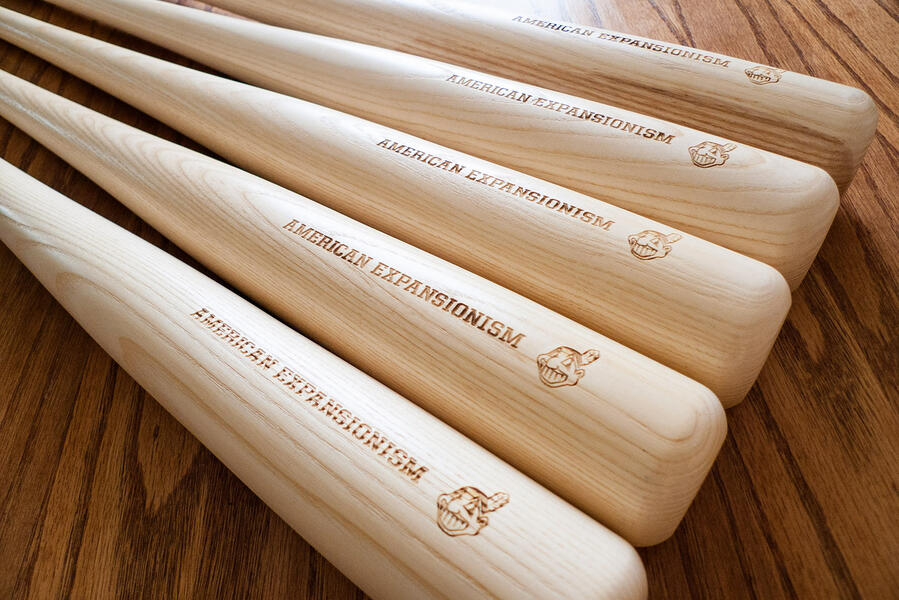 American Expansionism (editioned engraved baseball bats)
American Expansionism (editioned engraved baseball bats)




